

Addressing Plastic Pollution in Goa: Preserving Paradise
- February 5, 2024
- Post Comment

Nestled along India’s western coast, the picturesque state of Goa captivates visitors with its pristine beaches, lush landscapes, and vibrant culture. However, amidst its natural splendour lies a pressing concern – plastic pollution. Despite its allure, Goa grapples with the pervasive issue of plastic waste, jeopardizing its ecosystems, biodiversity, and tourism-dependent economy. Understanding the ramifications of plastic debris and exploring sustainable solutions are imperative to safeguarding Goa’s natural treasures and fostering a resilient future.
The Impact of Plastic Pollution on Goa’s Environment
Coastal and Marine Contamination: Goa’s idyllic beaches are marred by the accumulation of plastic debris, posing threats to marine life and coastal aesthetics. Sea turtles mistake plastic bags for prey, leading to ingestion and fatal consequences, while seabirds suffer from ingestion of plastic fragments, disrupting marine ecosystems.
Biodiversity Under Siege: Goa’s diverse marine ecosystems face peril due to plastic pollution, with corals suffocating and aquatic species ingesting microplastics, introducing toxins into the food chain. This not only endangers marine life but also poses health risks to humans consuming contaminated seafood.
Tourism Downturn: Plastic contamination tarnishes Goa’s tourism appeal, deterring visitors from seeking unspoiled landscapes. Negative perceptions, dwindling tourist numbers, and economic losses underscore the urgency of addressing plastic waste to safeguard Goa’s tourism industry.
Water Quality Concerns: Plastic waste contaminates water sources, endangering aquatic life and human health through toxin leaching. Proper waste management is essential to prevent further degradation of Goa’s water bodies.
Human Health Implications: Plastic pollutants introduce harmful chemicals into the environment, posing health risks to individuals through contaminated food and water sources.
Waste Management Challenges: Goa grapples with inadequate waste management infrastructure, exacerbating plastic pollution. Effective waste management systems are crucial to curbing plastic waste proliferation.
Long-term Environmental Threats: Persistent plastic pollutants degrade into microplastics, infiltrating marine ecosystems and potentially entering the human food chain, underscoring the need for proactive mitigation measures.
Government Initiatives to Combat Plastic Pollution
The Goa government has implemented various measures to curb plastic usage and mitigate pollution:
Plastic Ban: Prohibition of single-use plastic products to reduce non-biodegradable plastic consumption.
Plastic Waste Management Rules: Regulations governing plastic waste treatment, segregation, and recycling to promote sustainable waste management practices.
Clean-Up Campaigns: Collaborative efforts with NGOs and volunteers to conduct beach clean-up drives, fostering community engagement in environmental conservation.
Plastic-Free Events: Encouraging plastic-free practices at public gatherings and events to promote eco-friendly alternatives.
Plastic-Free Zones: Establishment of designated plastic-free areas to showcase sustainable practices and encourage behavioural change.
Strategies to Further Reduce Plastic Waste in Goa
Promoting Eco-friendly Alternatives: Collaborating with local businesses to provide eco-friendly substitutes and incentivizing their adoption through partnership programs.
Celebrating Tradition: Incorporating traditional practices that prioritize natural materials into cultural events and promoting regional craftsmanship of sustainable products.
Artistic Interventions: Engaging local artists in creating public art installations from recycled plastic waste to raise awareness and inspire behavioural change.
Education Initiatives: Integrating environmental education into school curricula and empowering students to initiate plastic waste reduction initiatives.
Supporting Local Efforts: Establishing a fund to support community-driven initiatives for plastic waste reduction and highlighting successful projects through media platforms.
Empowering Tourists in Plastic Reduction Efforts
As a responsible tourist, you can contribute to plastic waste reduction in Goa by
Utilizing Reusable Alternatives: Bringing reusable water bottles, coffee cups, and utensils to minimize single-use plastic consumption.
Responsible Disposal: Properly disposing of waste in designated bins to prevent plastic pollution, especially in sensitive areas like beaches.
Supporting Sustainable Businesses: Patronizing businesses that prioritize eco-friendly practices to incentivize sustainable alternatives.
Water Conservation: Conserving water during your stay and reporting wasteful practices to promote efficient water management.
Choosing Locally Produced Goods: Opting for regionally sourced, environmentally friendly products with minimal packaging to reduce plastic usage.
Participating in Conservation Efforts: Volunteering for beach clean-up initiatives and conservation projects to actively contribute to plastic waste reduction.
Addressing plastic pollution in Goa requires collaborative efforts from the government, businesses, residents, and tourists alike. By embracing sustainable practices, fostering community engagement, and promoting eco-conscious tourism, Goa can preserve its natural beauty for generations to come. Together, let us pledge to safeguard Goa’s paradise and create a more sustainable future.
Read More...

EP Kamat Group and Goa State Pollution Control Board Introduce ‘The Planet Care Innovation Challenge’ for Global Sustainability Drive

Goa’s Cultural Diversity and Sustainable Tourism Initiatives Take Center Stage at ITB Berlin 2024

OneEarth Foundation Unveils “Drive Against Plastic Pollution” Initiative to Combat Marine Plastic Pollution Along the Goa Coastline

Exploring Goa’s Rich Biodiversity Through Art, Music, and Eco-Conscious Design

Goa’s Hospitality Industry Leading The Charge in Sustainable Practice

Efficient Strategies for Minimizing Food Waste in Hospitality Industry : A Comprehensive Approach

Ginger Goa, Panjim Achieves Prestigious Green Hotel Certification

Embracing Sustainable Chic: The Shop Redefines Aesthetic Living in Goa

Celebrating Sustainability: Goa’s Journey Towards Regenerative Tourism
Last updated 27/06/24: Online ordering is currently unavailable due to technical issues. We apologise for any delays responding to customers while we resolve this. For further updates please visit our website: https://www.cambridge.org/news-and-insights/technical-incident
We use cookies to distinguish you from other users and to provide you with a better experience on our websites. Close this message to accept cookies or find out how to manage your cookie settings .
Login Alert

- > Journals
- > Environment and Development Economics
- > Volume 27 Issue 2
- > Air pollution trade-offs in developing countries: an...

Article contents
- Study area and data
- Empirical analysis and results
- Conclusions
Air pollution trade-offs in developing countries: an empirical model of health effects in Goa, India
Published online by Cambridge University Press: 11 June 2021
- Supplementary materials
Developing countries experience both household air pollution resulting from the use of biomass fuels for cooking and industrial air pollution. We conceptualise and estimate simultaneous exposure to both outdoor and household air pollution by adapting the Total Exposure Assessment model from environmental health sciences. To study the relationship between total exposure and health, we collected comprehensive data from a region (Goa) in India that had extensive mining activity. Our data allowed us to apportion individuals’ exposure to pollution in micro-environments: indoor, outdoor, kitchen, and at work. We find that higher cumulative exposure to air pollution is positively associated with both self-reported and clinically- diagnosed respiratory health issues. Households in regions with higher economic (mining) activity had higher incomes and had switched to cleaner cooking fuels. In other words, household air pollution due to higher biomass use had been substituted away for outdoor air pollution in regions with economic activity.
JEL classification
1. background.
Nine out of ten people worldwide breathe polluted air, with one out of nine deaths in 2012 attributed to air-pollution related conditions (WHO, 2016a ). Air pollution represents the most significant environmental risk to health. Developing countries experience the worst of both household air pollution resulting from biomass fuels for cooking and the air pollution resulting from industry and transport. While it is widely recognised that outdoor air pollution levels in developing countries often exceed the World Health Organization (WHO) guidelines, India among other developing countries suffers severely due to household air pollution (HAP) arising primarily from biomass cooking fuels (Smith et al., Reference Smith, Bruce, Balakrishnan, Adair-Rohani, Balmes and Chafe 2014 ; Jeuland et al., Reference Jeuland, Pattanayak and Bluffstone 2015b ). Approximately 3 billion people, mostly in low-income countries, continue to use solid fuels (fuelwood, animal dung and crop waste) for cooking and heating (WHO, 2014 ), contributing to both deforestation (Bailis et al., Reference Bailis, Drigo, Ghilardi and Masera 2015 ) and global climate change (Ramanathan and Carmichael, Reference Ramanathan and Carmichael 2008 ).
Exposure to air pollution results in a wide range of acute and chronic health outcomes ranging from minor physiological changes to death from respiratory and cardiac diseases (Bascom et al., Reference Bascom, Bromberg, Costa, Devlin, Dockery and Frampton 1996 ; Dominici et al., Reference Dominici, McDermott, Zeger and Samet 2003 ; Gauderman et al., Reference Gauderman, Urman, Avol, Berhane, McConnell and Rappaport 2015 , Reference Gauderman, Vora, McConnell, Berhane, Gilliland and Thomas 2007 ). Epidemiological studies (Ezzati and Kammen, Reference Ezzati and Kammen 2002 ; Salvi and Barnes, Reference Salvi and Barnes 2009 ; Lozano et al., Reference Lozano, Naghavi, Foreman, Lim, Shibuya and Aboyans 2012 ; Mannucci and Franchini, Reference Mannucci and Franchini 2017 ) have estimated that in addition to ambient (or outdoor) air quality, there is robust evidence that HAP poses a serious threat to human health, especially in low-income countries that still use biomass fuels as an energy resource. The WHO estimated that air pollution was responsible for nearly seven million deaths every year, with 4.3 million due to HAP (WHO, 2014 ). Women and young children bear a disproportionately large burden of mortality, with 500,000 children under five that die due to acute respiratory infections (Langbein, Reference Langbein 2017 ).
In addition to exposure to outdoor and household air pollution, workplace exposure could pose a potential risk to health. Millions of workers in a variety of occupations, such as mining, construction and abrasive blasting, are exposed to high levels of airborne dust particles. Inhalation of these particles may cause respiratory diseases such as bronchitis, silicosis and pneumoconiosis. Prevalence rate or trends in occupational respiratory problems in developing countries are mostly unknown, but the magnitude of the problem could be substantial (WHO, 2016b ). The exposure to work-related pollution in our study includes a source of pollution not studied often, which is mining.
Jeuland et al. ( Reference Jeuland, Pattanayak and Bluffstone 2015b ), in their review of HAP at a global level, used a conceptual model. Our attempt is to use a conceptual model in this specific, local context. In this study, we conceptualize an integrated framework to estimating cumulative exposure to air pollution over time and space that results in poor health, irrespective of whether it originates in a stove or a mine. Pollution is not only caused by mining and associated transport, but also by the combustion of fuels for cooking in the household. We estimate the simultaneous exposure to both outdoor and household air pollution by measuring pollutant concentrations and time spent in each location. We develop a model borrowing from conceptual foundations in environmental health sciences and the economics of households in developing countries. Specifically we draw from health production models (Harrington and Portney, Reference Harrington and Portney 1987 ), agricultural household models (Singh et al., Reference Singh, Squire and Strauss 1986 ), and a branch of environmental health sciences called Total Exposure Assessment (Smith, Reference Smith 1993 ). Our analytical model examines the relationship between the cumulative exposure to air pollution from outdoor and cooking sources of individuals in a rural household in a developing country and their health. The empirical implementation of this framework that incorporates both household and outdoor air pollution required the use of a household questionnaire which included time budget questions, measurement of air pollution concentrations in different micro-environments, health diaries for self-reporting ailments and doctor visits, and clinical measurements of respiratory health.
Total exposure is the result of people spending time in different micro-environments (for example, indoors, in the kitchen, and outdoors) with different levels of air pollution concentration levels. Pitt et al. ( Reference Pitt, Rosenzweig and Hassan 2006 ) stressed the importance of gathering data on time allocation across different micro-environments. They used micro-data to examine how household structure affects the distribution of cooking time among women in rural Bangladeshi households, and the health effects of cooking time, as a proxy for exposure to HAP. Our study takes it further by unpacking the micro-environments into outdoor, indoor and work besides the kitchen. We chose a region where pollution due to iron ore mining and transportation activity heavily contributes to outdoor air quality, to study the relationship between cumulative exposure in different micro-environments and health.
The exposure is cumulative and over time leads to higher susceptibility to respiratory problems. As we aimed to study the relationship of total exposure with air pollution, we chose to study a region that characterises both household and outdoor air pollution in India. We collected data from regions which had varying levels and lengths of mining activity in Goa, India. In Goa, we studied this process in different mining clusters, with different levels of cumulative exposure among the population. The paper firstly examines the socio-economic correlates of time spent in polluting environments by individuals, followed by the choice of cooking fuel by households. We unpack the contributors to cumulative exposure, by apportioning it to different micro-environments, time spent in these environments and the type of fuel used. We finally examine the relationship between cumulative exposure to air pollution and respiratory health indicators.
We find that gender and age are associated with the time spent by individuals indoors, in the kitchen and outdoors, with middle-aged women spending much time cooking. We find that households in regions with higher mining activity had higher incomes on average and a higher proportion of cleaner fuels (LPG) used for cooking. Active mining clusters which experienced higher outdoor pollution levels had a significantly lower proportion of households that used polluting biomass fuels for cooking. In other words, HAP from biomass fuels is substituted with outdoor air pollution in regions with higher economic activity. Finally, we find that higher cumulative exposure is associated with higher levels of morbidity: (a) reported health measures are respiratory sick days and chronic respiratory sick days, and (b) observed clinical health measures are the doctor's diagnosis of the X-rays and lung function tests. Our use of two methods to measure health indicators – self-reported health and clinical examination – strengthens the validity of our results.
In section 2 , we describe our study area and examine our data. In section 3 , we develop our theoretical model and present our results in section 4 . We discuss the results and conclude in section 5 .
2. Study area and data
Our study area was the heavily iron ore mined regions of Goa, India. Iron ore mining was an integral part of the state's economy for almost fifty years and contributed to 60 per cent of India's iron ore exports at the time of the study (2003). Given the scale of iron ore mining in Goa and the documented environmental issues, it was an ideal setting to study total exposure to air pollution. Footnote 1 For the purposes of this study, we divided the mining regions of Goa into five clusters, including a control cluster with no mining activity at the time of data collection between June 2003 and May 2004. These clusters were chosen to have varying vintage and levels of mining activity. Cluster 1 was the mining region with the earliest mining activity (over 40 years at the time of the study) but where the activity had subsided relative to Cluster 2, the most intensively mined cluster, where mining had begun approximately 25 years prior to this study. Cluster 3 was the region where mining activity was relatively at its inception, having begun 15 years prior to the study. Cluster 4 was the mining corridor, that is, the region where trucks transported the ore from the mines to the barges or the coast. Cluster 5 was the control region that was away from the mining region and with no history of mining activity at the time of this study.
Table 1. Sample size distribution across villages and clusters

The survey questionnaire had two modules: household and individual. Both questionnaires were conducted as a personal interview between the enumerator and the individuals, including the head of the household, who also responded to the household questionnaire. The questionnaires were translated into the local language and pilot tested before the actual surveys were carried out by trained enumerators (mostly local social workers).
2.1. Household survey
The first survey in the sampled households was administered to the head of the household and included questions eliciting demographic information, household income, housing characteristics (such as number of rooms, whether the kitchen has windows or exhaust fan), fuel and stove types (see the online appendix for the questionnaires and health diaries). Table 2 presents the summary statistics of the household characteristics used in the empirical analysis.
Table 2. Summary of variables used in regressions
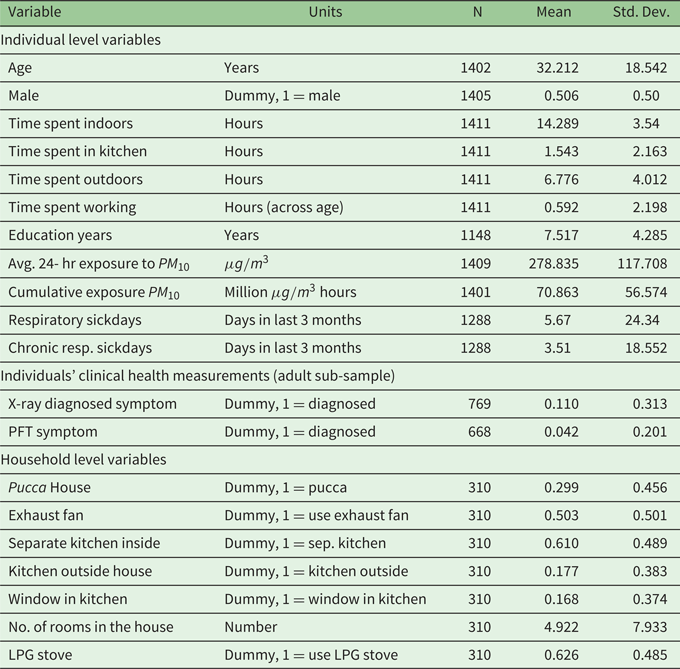
2.2. Individual survey
The individual survey was conducted with each member of the household to gather detailed information on smoking status, occupation, time spent in each micro-environment and health status. We used the standardized respiratory health questions of the British Medical Research Council. For children (those aged 15 or below) the individual surveys and time activity information was collected from their mothers (or primary caretakers). The surveys used the recall method to ascertain the specific health problems in the last three months that were self-reported by the individuals, including doctor visits and fees. Given the focus on respiratory health in this study, illnesses reported in the individual survey were classified into three groups by the cardio-respiratory specialist, namely: (1) upper respiratory (illnesses and symptoms related to the upper respiratory tract that could be linked to air pollution, but not necessarily prolonged exposure); (2) lower respiratory (chronic illnesses related to the lower respiratory tract that are likely to occur as a result of prolonged exposure to air pollution); and (3) all other illnesses. In our main estimations, we use the sick days attributed to upper respiratory illness as respiratory sick days and the sick days from lower respiratory illness as chronic respiratory sick days (Cooper et al., Reference Cooper, Sridharan, Uma, D'Souza, Murugesan and Dayal 2006 ).
The time budget (or time spent in the various micro-environments) of these individuals in a day was collected through the individual questionnaire. Responses were further verified by a field assistant when making household measurements. In addition, subjects in each household were provided health diaries (in Marathi, the local language) and asked to record details on type and days of illness, visits to the doctor, doctor fees, work lost and cost of treatment. Table 2 summarizes the key individual level information collected.
2.3. Air pollution measurement
Outdoor air samples were collected through high volume air samplers (Envirotech, India). The outdoor concentrations were measured in three locations in each of the four mining clusters. One location was chosen for outdoor concentration measurement in the control cluster. The sampling in each location was continuous for three days in two seasons, and the filters were replaced every 8 hours. After sampling, RSPM levels were calculated by the gravimetric method (difference in the weight of filter paper after sampling divided by volume of air sampled). The daily 24-hour average concentration was derived for each cluster from this data. RSPM sampling in the workplace was carried out for working hours in a day (about 8 hours) with a low volume personal air sampler (SKC, UK) for a sub-sample of 18 subjects working in mining-related occupations.
2.4. Health tests and diagnosis
The clinical measures were conducted by trained technicians in local clinics for a sub-sample of individuals from the sampled households. We collected data on the chest X-rays for 769 adults (900 including children) and pulmonary lung function test (PFT) for 668 adults (782 including children). The chest X-ray and PFT reports were analyzed and diagnosed by a cardio-respiratory health specialist for chronic respiratory symptoms. The X-rays are expected to highlight the impacts of long-term exposure while PFT measures lung efficiency/capacity at the time of the test. We use the specialist's interpretation of the reports by creating dummy variables: X-ray symptom (equals 1, if diagnosed “not normal”) and PFT symptom (equals 1, if PFT results were diagnosed as “not okay”). The X-ray reports were provided to the subjects after the radiologist's and specialist's diagnosis. Footnote 2
2.5. Fuel usage
In the overall sample, the fuel categories of biomass only, liquefied petroleum gas (LPG) only, and biomass and LPG account for almost equal proportions ( table 3 ). However, there are sharp contrasts in the shares of fuels among the clusters. As expected, the control cluster, which is a relatively less connected region, has a very high proportion of households (79 per cent) that use biomass fuels only. In contrast, the corridor cluster, with better road connectivity and where we would expect the highest LPG availability, has the highest proportion of LPG only users (68 per cent). Clusters 1, 2 and 3 exhibited lower LPG usage than the corridor (but higher than the control region) and lower biomass only use compared to the control cluster (but higher than the corridor). The control cluster also had the highest number of kitchens located outside the house, while the corridor had the least. The mean income in the corridor was the highest (lowest in the control region) and the corridor correspondingly has the highest percentage of separate kitchens inside the household (the control the lowest). The income distributions among clusters observed in table 3 partly explain the fuel usage patterns, where the households with higher income (mining activity regions) had higher usage of cleaner fuels compared to the control cluster which had the lowest mean income. Footnote 3
Table 3. Fuel usage, income and concentration across clusters (%)
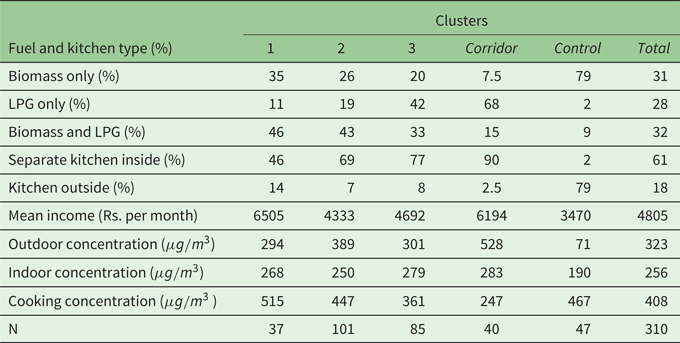
Note : Indoor concentration was measured in each household; outdoor in three locations per cluster.
Cooking concentration was measured in a sub-sample for each fuel type which was used to estimate the household concentration based on the fuels used. The fuel use percentages do not add up to 100% as some households did not have a kitchen (or do not report cooking).
2.6. Air quality and exposure
Table 4. Illustration of total exposure calculation for an individual

The average 24-hr exposure for this individual is equal to:
2.7. Cumulative exposure
The cumulative exposure to air pollution is the total 24-hr exposure to pollutants summed up over the years of residence for the individual in the region Footnote 4 as:
Figure 1 captures the key argument of this paper. In the top panels of figure 1 , we see that the distribution of outdoor concentration is very different from that of indoor concentration and cumulative exposure. In the far left scatter plot in the bottom panels of figure 1 , in which we have plotted indoor concentration on the y -axis and outdoor concentration on the x -axis, we can see that there is a very low correlation between the two. Some observations are characterised by high values of indoor concentration and low values of outdoor concentration. This reinforces the claim that using either as a measure of exposure is inadequate. Outdoor concentrations only vary by cluster, and would be particularly inadequate, though their measurements would be reasonably accurate. Studies which focus on ambient (outdoor) concentration or household (indoor) air pollution in isolation may also fail to document the relationship between outdoor and indoor air quality in such a setting. In the other two scatterplots in the bottom panels of figure 1 , we see that cumulative exposure has a weak positive relationship with outdoor concentration and a relatively stronger positive relationship with indoor concentration.
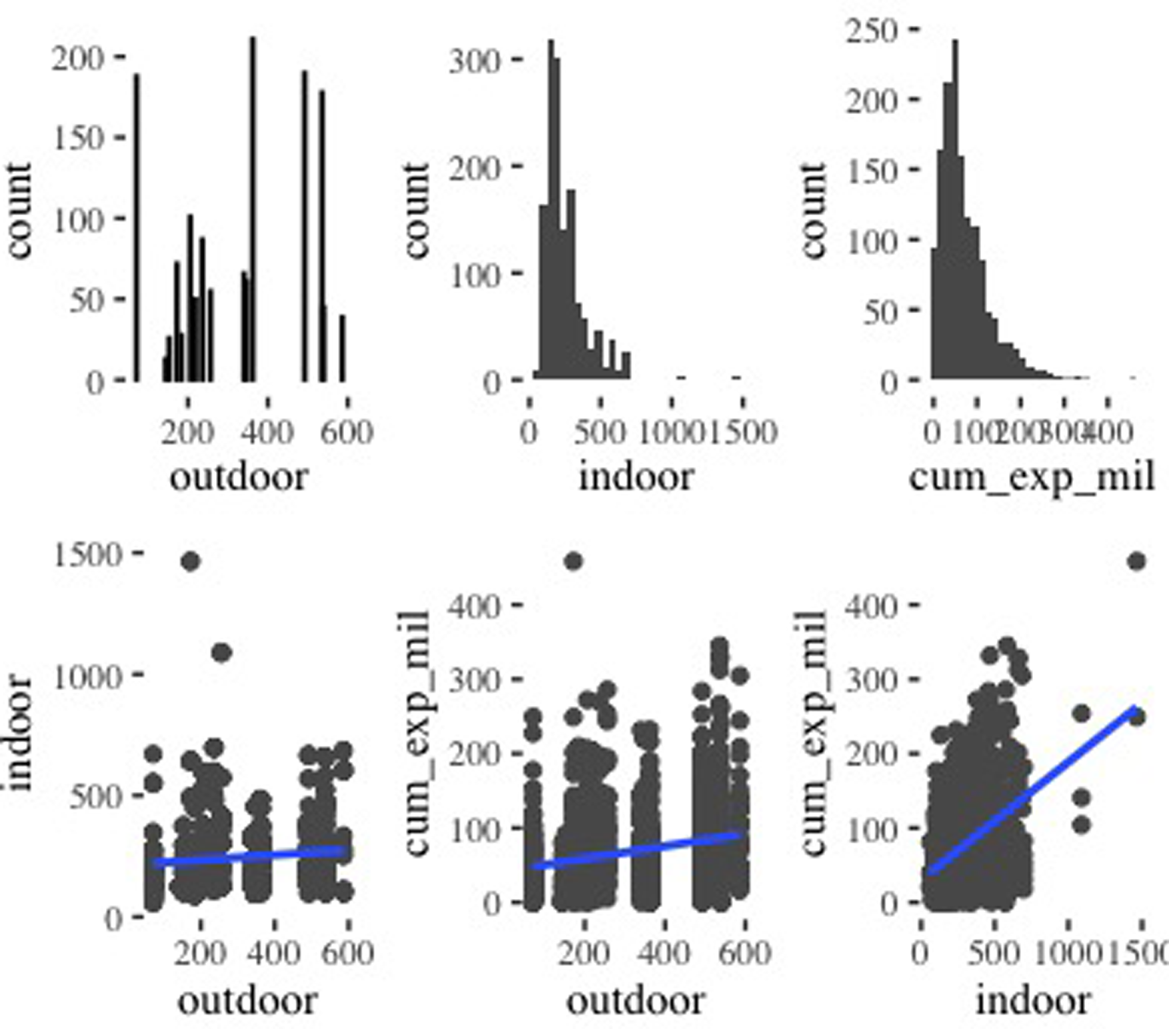
Table 5 presents the two sample t-test for difference of means in exposure for the four mining clusters compared to the control cluster. Outdoor exposure in column (1) is higher in all the clusters (with mining activity) compared to the control region (with no mining activity), with Cluster 4 (the mining corridor) recording the highest outdoor exposure. On the other hand, Cluster 3 and the Corridor have lower cooking exposure (column (3)) compared to the control region, due to a higher proportion of LPG usage. The average 24-hr exposure in column (4) is a weighted measure of exposure to different micro-environments and is higher for all four clusters compared to the control.
Table 6 reports the time spent in micro-environments as elicited in the individual recall survey. The field assistants were able to verify the reported time spent during the household air quality measurements, but this would not completely address the issues with recall methods. In the empirical results section, we discuss how we try to address this concern.
Table 6. Time spent in micro-environments (hrs/day) and exposure
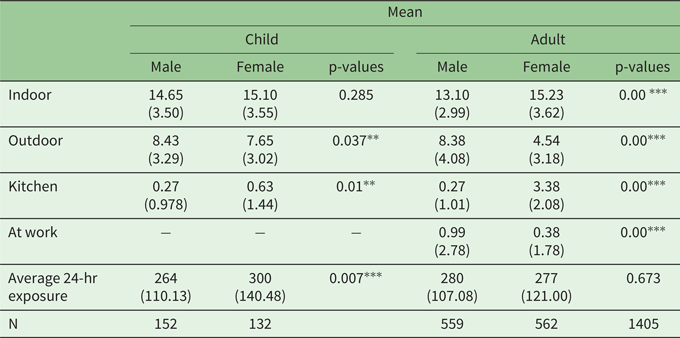
Men (adult males) spend 8.4 hours outdoors on average, and women (adult females) about half of that. Time spent by women in the kitchen on average is about 3.4 hours, while men on average spend less than half an hour. And yet, on average, the 24 hour average exposure is 280 micrograms per cubic metre for males and 277 for females, so total exposure balances out on average, in line with this paper's argument that we need to consider micro-environments together rather than separately.
3. The model
We now discuss how we conceptualize our theoretical model that accounts for exposure to air pollution across micro-environments. Jeuland et al. ( Reference Jeuland, Pattanayak and Bluffstone 2015b ) use a conceptual model to help explain and think about issues in their excellent review of global HAP. We develop a model drawing on health production models (Harrington and Portney, Reference Harrington and Portney 1987 ), agricultural household models (Singh et al ., Reference Singh, Squire and Strauss 1986 ), and a branch of environmental health sciences, Total Exposure Assessment (TEA) (Smith, Reference Smith 1993 ). In health production models, health is an outcome of a production function. Agricultural household models try to model consumption and production activities of rural households in developing countries in the same model. TEA in the context of air pollution examines pathways from all sources of air pollution to exposure by humans.
We view the household model as an abstraction that captures key elements of HAP in Goa. Footnote 5 There is an obvious element of simplification and we note caveats at different points.
3.1. Theoretical model
The kinds of sickness that result from poor nutrition and from household pollution are different. The knowledge of or beliefs in causes of sickness of different sorts is a key variable that influences the household's actions (Jeuland et al., Reference Jeuland, Pattanayak and Bluffstone 2015b ).
While the time spent in different micro-environments is person specific, the concentrations are not. To simplify, we assume that the time spent by the child in the four different micro-environments is the same as that of the adult female.
We note that the concentration outdoors will be influenced by the total cooking pattern in a village; most notably the contrast will be between a village where every household uses LPG only and a village where every household uses biomass only.
Similar to the concentration of air pollution in the cooking environment, the concentration indoors will depend on time cooking and the concentration outdoors, such that
The total amount of food cooked in the household is a function of the time spent cooking:
Equation ( 1 ) may give the impression that more cooked food requires more cooking time irrespective of fuel, but LPG cooking can reduce cooking time compared to biomass cooking.
Since the adult male does not cook or gather biomass, the expressions for time indoors and time outdoors are different in the case of the adult male,

The household maximizes utility subject to the following budget constraint:
The first-order conditions are (denoting the Lagrange by L):
Equation ( 2 ) is the usual consumer theory condition for consumption and says that the marginal utility from an additional unit of consumption should equal the marginal cost in utility terms, which is the product of the multiplier and the price.
A change in time spent cooking with LPG or biomass is associated with higher emissions and therefore higher exposure and sickness (of all members), and higher cooked food and therefore lower sickness. It will also entail greater cost concerning the gathering of biomass or expenditure on purchase of fuel and raw food. The household will have imperfect information about the effects of cooking on exposure. Moreover, cooking affects women and children more than adult males since they stay in the cooking micro-environment:
A change in time cooking has several effects on exposure, since it affects the time spent in different micro-environments (in the case of the adult female and the child) and the concentration in the indoor and cooking micro-environment. So, for example,
Our model is static for simplicity. However, in reality, what we witness today is the outcome of the past. Mining tends to follow a life-cycle, with the initial expansion of mining and economic activity in an area finally leading to a slowing down of mining as new areas are found and exploited. During this mining life-cycle, the economic context and the environment (of which air pollution is one indicator) of the households change. Moreover, human health is affected by cumulative exposure, especially in the case of chronic air pollution-related ailments. In our main estimations, we study the association between cumulative exposure and health.
4. Empirical analysis and results
Following from the theoretical model, our primary objective is to estimate the relationship between cumulative exposure to air pollution and measures of respiratory health. Secondly, we characterize the socio-economic associations of time spent in micro-environments with different pollutant concentrations, and of fuel-choice. We also estimate the relationship between fuel usage and concentrations in the micro-environments. We model our primary relationship between cumulative exposure to air pollution and respiratory health using the following regression equation:
4.1. Time in micro-environments
We begin by estimating the associations of time spent in micro-environments (reported in table 7 ), where we include biomass fuel usage and interact its usage with the female dummy along with the individual and household characteristics, as we discussed in theory (where we assumed that only females gathered biomass). The individual level attributes are age, age-squared, gender and never-smoker (dummy), and the household characteristics include the number of adults and children by gender and whether or not the house was pucca (constructed with solid materials as a permanent dwelling).
Table 7. Time spent in micro-environments
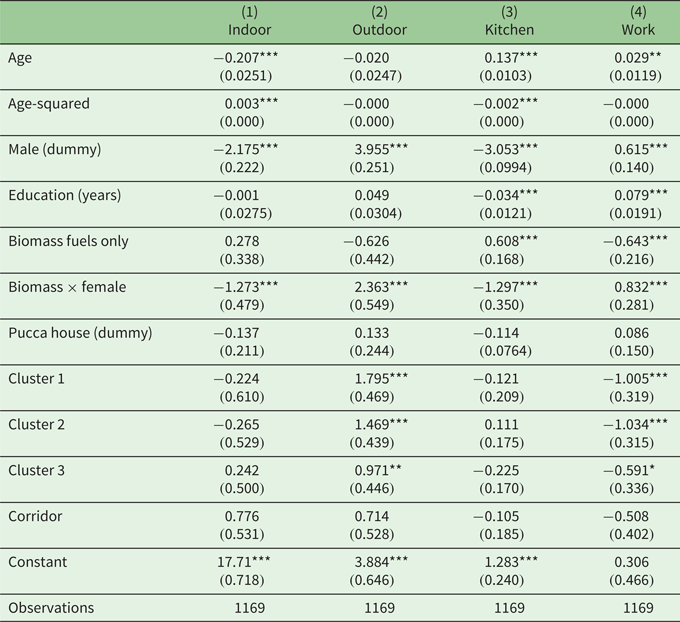
Standard errors in parentheses and clustered at household level.
Other controls: number of adults and children (by gender).
Table 7 presents the results of regressions on the dependent variables of time spent: indoors, outdoors, in the kitchen and at work. We control for cluster level differences by including cluster dummies in our estimation. For time spent in the kitchen, we examine mean time spent in the kitchen by adults in the household. The time adults spend in the kitchen is expected to depend on the composition of adults and children, since one person can cook for several members. We therefore include the number of adults and children in the household by gender in these regressions.
4.2. Choice of fuel
In table 8 , we present the relationship between household characteristics and their choice of fuel, biomass or LPG. The unit of observation here is the household (N = 308) and we estimate a linear probability model. Footnote 6 As a robustness check, we estimated the models with a binary dependent variable using a maximum likelihood method and find similar results (see columns (2) and (4) in table 8 ).
Table 8. Household fuel choice: biomass and LPG
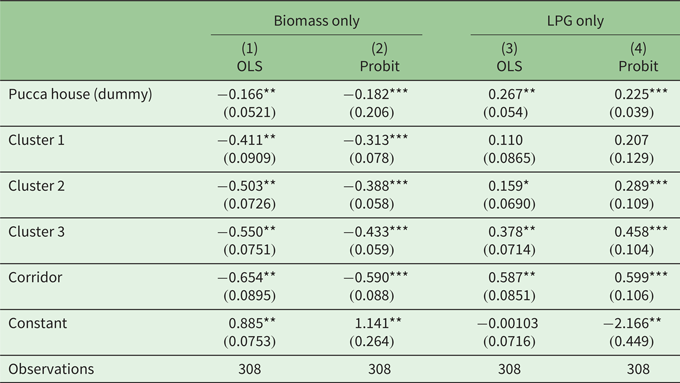
Estimations at household level; probit marginal effects reported in columns (2) & (4).
Other controls: number of adults and children in the household (by gender).
The dependent variables in table 8 are households who used biomass or LPG for cooking. We include the cluster dummies in the specifications. The regressor pucca house (dummy) is negatively associated with biomass only used for cooking – columns (1) and (2) – and positively for LPG only – columns (3) and (4), as pucca house proxies for higher income households. As expected, all four (mining-related) clusters are negatively associated with biomass only used for cooking compared to the control cluster. Except for Cluster 1, the other three mining clusters are more likely to be using LPG for cooking.
4.3. Health indicators
We now examine the association between cumulative exposure and health. In table 9 , we present the results for both reported health indicators (respiratory and chronic respiratory sick days) and clinically-diagnosed respiratory health (expert's diagnosis of the X-ray and lung function test (PFT)). The respiratory sick days (e.g., laryngitis, sinusitis, pharyngitis) and chronic respiratory sick days (e.g., asthma, bronchitis, wheezing, emphysema) were self-reported by the participants. According to clinical experts, respiratory health (measured by X-ray reports) is a function of cumulative exposure rather than immediate exposure (Cooper et al., Reference Cooper, Sridharan, Uma, D'Souza, Murugesan and Dayal 2006 ). As our key variable of interest is cumulative exposure to air pollution, the cardio-respiratory expert's diagnosis of X-rays provides the best measure of respiratory health for our purposes. Footnote 7 The pulmonary function test (as clinically measured with the peak flow meter instrument) indicates age-specific lung capacity and can be influenced by immediate 24-hr exposure.
Table 9. Cumulative exposure and health indicators
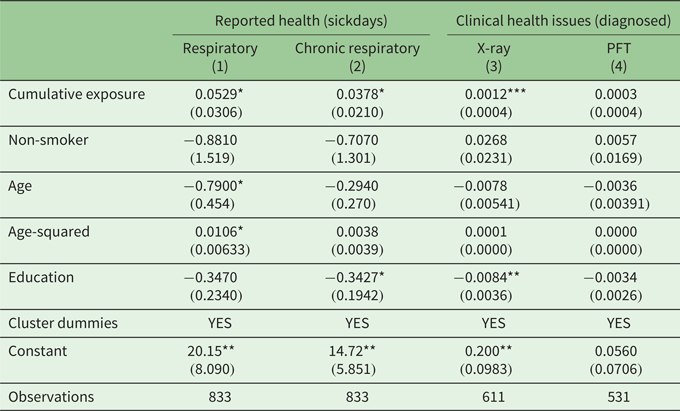
Standard errors (clustered at household level) in parentheses.
Estimated only for adults (so numbers lower than table 2 ).
Table 9 presents the main results of the paper, the association of health measures and cumulative exposure to air pollution for adults. In addition to the detailed survey questionnaire administered by local enumerators, sampled households were provided with individual health diaries to record the type of ailment, date, number of days sick, number of visits to the doctor, doctor's fees and any additional comments. We chose the self-reported sick days for respiratory and chronic respiratory illness as the dependent variables for the results presented in columns (1) and (2). The key variable of interest, cumulative exposure, is statistically significant and positive, indicating a positive association between exposure and respiratory sick days. In all the estimates in table 9 , we control for individual (age, age-squared, education, male dummy), household level pucca dummy and cluster dummies to account for fixed effects at the regional level. A one-unit change in cumulative exposure is associated with a 0.0529-unit change in respiratory sick days, shown in column (1), and a 0.0378-unit change in chronic respiratory sick days, shown in column (2). In terms of elasticity, a 1 per cent change in cumulative exposure (at the mean) is associated with a 0.79 per cent increase in respiratory sick days and a 0.86 per cent increase in chronic respiratory sick days.
Lastly, a crucial concern in the literature when using self-reported measures of health as the dependent variable are issues of under- (or over-) reporting (Short et al., Reference Short, Goetzel, Pei, Tabrizi, Ozminkowski and Gibson 2009 ; Vaillant and Wolff, Reference Vaillant and Wolff 2012 ). The use of health diaries may mitigate the concerns with self-reported health based on recall methods but does not completely address issues of the heterogeneity problem in reporting, since different populations may use different threshold levels when asked about their health (Shmueli, Reference Shmueli 2003 ; Lindeboom and Van Doorslaer, Reference Lindeboom and Van Doorslaer 2004 ). Studies find correlations between attributes such as education and self-reported health which may arise from measurement errors in self-assessment. We ameliorate some of these concerns by controlling for education and income. Furthermore, the results in columns (3) and (4) in table 9 , where the dependent variables are diagnosed clinical measures of health, are consistent with our findings with self-reported health.
As noted, we were advised by the cardio-respiratory specialist that respiratory health (indicated by X-ray reports) is a function of cumulative exposure. Therefore we argue that a diagnosed respiratory issue with the X-ray reports is the key health indicator in our study (column (3) in table 9). The pulmonary function test (as clinically measured with the peak flow meter instrument) indicates age-specific lung capacity and can be influenced by immediate 24-hr exposure, so it will be more responsive to 24-hr average exposure as a determinant.
Columns (3) and (4) in table 9 present the results for the relationship between cumulative exposure and clinically-diagnosed respiratory health status. A sub-sample (about 50 per cent of the total) of individuals volunteered for these medical tests that were offered for free and these observations are therefore lower than previous individual level regressions. In column (3) we use the X-ray diagnosis by the respiratory health expert and find a positive relationship between cumulative exposure to air pollution and an X-ray report diagnosed with respiratory problems. In terms of elasticity, a 1 per cent change in cumulative exposure is associated with a 0.90 per cent change in the likelihood of an X-ray report diagnosing a respiratory issue. Column (4) reports a positive association between cumulative exposure and the lung function test (i.e., ‘PFT not okay’) although not statistically significant. A 1 per cent change in exposure is associated with a 0.75 per cent change in the PFT measure recording an abnormality. As we noted, PFT is responsive to recent exposure and therefore noisily captures long-run effects.
The finding in our study that the relationship between cumulative exposure and health indicators is similar (in terms of sign and significance for X-ray measure) for both self-reported measures as well as clinical assessments is useful to related studies. The detailed clinical assessment and medical expert diagnosis, as in our study, may be infeasible to collect or the data and resources may not be available. The positive correlation we find between clinical and self-reported health illustrates the value of other field studies even if they only use self-reported health.
4.4. Study limitations
Our study has some limitations. Firstly, part of the study uses survey data and the recall method for self-reported health, which is open to measurement errors and biases. Self-reports are amenable to social desirability biases when responding to questions about health (Ezzati et al., Reference Ezzati, Martin, Skjold, Hoorn and Murray 2006 ), for example, when responding to questions about smoking habits in our survey. Our provision of health diaries at the start of the study to all sampled households could have potentially improved participant's recording and recall during the health survey. We find consistent results with the clinical measures of health. Participants’ reports of time spent in micro-environments can be affected by such biases as well, but the presence of field assistants in the households during the indoor and kitchen concentration measurements and their independent verification of time spent should constrain the bias.
Although we cannot make causal claims in the paper about the effect of mining or traditional fuel usage on health, our elaborate data collection allows us to make careful inferences about source apportionment for pollution. We treat the assignment of mining activity as exogenous to households in our computation of cumulative exposure, but selective in- or out-migration could bias our estimates. Even if we do not deal with the out-migration issue, the fact that 77 per cent of our sampled households were originally from the cluster (the main results are qualitatively similar when restricting the analysis to this sub-sample) allows us to have confidence in the results.
Sophisticated treatments of costs and benefits have been published since the data collection for this study (Jeuland et al., Reference Jeuland, Bhojvaid, Kar, Lewis, Patange and Pattanayak 2015a , Reference Jeuland, Soo J-S and Shindell 2018 ). Our particular contribution is the incorporation of total exposure and micro-environments. Air pollution valuation studies may to some extent abstract from that or, at times, simply ignore HAP.
5. Conclusions
Our study develops an integrated empirical model to study the association between respiratory health and total air pollution (household and outdoor). The two distinct features of this paper are: (1) proposing an integrated empirical model of health effects of air pollution, and (2) using dis-aggregate data on exposure in different environments to test the empirical implications from the model. The delineation of exposure levels from different micro-environments offers insights into the comparative magnitude of impacts from both household and outdoor pollution. This approach has allowed us to examine the relationship between respiratory health and household and outdoor air pollution together.
In our empirical analysis, we examine: (a) the association between individual characteristics and time spent in different micro-environments, (b) the distribution of concentrations in the micro-environments among clusters, (c) the relationship between clusters and household fuel usage, and (d) the relationship between cumulative exposure to air pollution and health outcomes. To highlight, we found that: (a) biomass use was positively associated with time spent in the kitchen, which may be due to the lower efficiency and higher cooking time associated with biomass fuels; (b) there is a positive association between outdoor air pollution and LPG usage (negative between outdoor and biomass use) which, along with associated results on the cluster dummies, implies that regions with mining activity had a higher likelihood of LPG usage; (c) cumulative exposure is positively related to biomass fuel usage, time spent in the kitchen where biomass fuels were used, household and outdoor air quality; and (d) cumulative exposure to air pollution is positively associated with self-reported and clinically-diagnosed respiratory issues.
Our results emphasize the findings in several studies that HAP from traditional cooking technologies adversely affects respiratory health (Duflo et al., Reference Duflo, Greenstone and Hanna 2008 ; Langbein, Reference Langbein 2017 ; Jeuland et al., Reference Jeuland, Soo J-S and Shindell 2018 ; Pattanayak et al., Reference Pattanayak, Jeuland, Lewis, Usmani, Brooks and Bhojvaid 2019 ). We find that switching from traditional biomass cooking to LPG stoves is associated with a substantial reduction in cumulative exposure, which is similar to findings in the literature on fuel switching (Shupler et al., Reference Shupler, Godwin, Frostad, Gustafson, Arku and Brauer 2018 ).
Findings from such a cross-disciplinary team can offer several direct implications for policy making. We chose a setting with a recognized outdoor air quality problem – a heavily-mined region in India – to study the relationship of both outdoor and household air pollution with health. Our design and data allowed us to compute total exposure to air pollution as an outcome of air quality and time spent in the micro-environment. Thus policies should not just focus on improving cooking technology and fuel choice, but also provide information that improves time allocations in polluted environments, including household kitchens.
In rural areas of developing countries – particularly in households using biomass fuels and poor kitchen ventilation – HAP is a relatively more significant health hazard. In our study, clusters with mining activity had a higher proportion of cleaner cooking fuel usage (LPG) than the control cluster, which relied on biomass fuels. Correspondingly, clusters with mining activity experienced an increase in outdoor air pollution and reduced HAP as they switched away from biomass fuels. The findings suggest that there may be trade-offs between indoor and outdoor air pollution: mining activity – while adversely impacting outdoor air pollution – may simultaneously increase income and reduce the costs of accessing cleaner stoves and fuels (LPG, electricity), therefore reducing HAP. The findings from this study can be treated as a proof of concept that economists can usefully borrow from the environmental health sciences (TEA). Further research is required to comprehensively identify and evaluate these trade-offs on health and other welfare outcomes.
Supplementary material
The supplementary material for this article can be found at https://doi.org/10.1017/S1355770X21000152 .
Acknowledgments
We thank the two anonymous referees, Anna Alberini, Dana Andersen, Kenneth McConnell, and numerous seminar participants at the University of Arizona and University of Maryland, College Park for their comments and suggestions; and Meena Sehgal and Sunil K. Chabbra for their input. We acknowledge the contribution and guidance of Sanghamitra Das who sadly passed away unexpectedly. We thank the International Development Research Center for their financial support.
Authors listed in alphabetical order.
1 At the time of this writing, iron ore mining has been banned in Goa (since 2018) and is estimated to have reduced the state GDP by approximately 25 per cent.
2 Subjects with diagnosed or potential problems were referred to their local doctors in the area for follow-up and required treatment.
3 Measuring income particularly of rural households is rife with issues (Ravallion, Reference Ravallion 1999 ) and we therefore include pucca house dummy as an additional control in our estimations.
4 This can be lower than the age of the individual if the family moved to this region from another region.
5 For an excellent review of studies on HAP, see Jeuland et al. ( Reference Jeuland, Pattanayak and Bluffstone 2015b ) who use a conceptual model to help explain and think about the issue.
6 In doing so, we have followed Angrist and Pischke ( Reference Angrist and Pischke 2008 ) recommendation of using the Linear Probability Model as they argue it does a good job of estimating the marginal effects even when the conditional expectation function is non-linear.
7 The X-rays were conducted and first interpreted by the local hospital clinical staff and later by the cardio-respiratory expert on the research team.

Das et al. supplementary material
Online Appendix

This article has been cited by the following publications. This list is generated based on data provided by Crossref .
- Google Scholar
View all Google Scholar citations for this article.
Save article to Kindle
To save this article to your Kindle, first ensure [email protected] is added to your Approved Personal Document E-mail List under your Personal Document Settings on the Manage Your Content and Devices page of your Amazon account. Then enter the ‘name’ part of your Kindle email address below. Find out more about saving to your Kindle .
Note you can select to save to either the @free.kindle.com or @kindle.com variations. ‘@free.kindle.com’ emails are free but can only be saved to your device when it is connected to wi-fi. ‘@kindle.com’ emails can be delivered even when you are not connected to wi-fi, but note that service fees apply.
Find out more about the Kindle Personal Document Service.
- Volume 27, Issue 2
- Sanghamitra Das (a1) , Vikram Dayal (a2) , Anand Murugesan (a3) and Uma Rajarathnam (a4)
- DOI: https://doi.org/10.1017/S1355770X21000152
Save article to Dropbox
To save this article to your Dropbox account, please select one or more formats and confirm that you agree to abide by our usage policies. If this is the first time you used this feature, you will be asked to authorise Cambridge Core to connect with your Dropbox account. Find out more about saving content to Dropbox .
Save article to Google Drive
To save this article to your Google Drive account, please select one or more formats and confirm that you agree to abide by our usage policies. If this is the first time you used this feature, you will be asked to authorise Cambridge Core to connect with your Google Drive account. Find out more about saving content to Google Drive .
Reply to: Submit a response
- No HTML tags allowed - Web page URLs will display as text only - Lines and paragraphs break automatically - Attachments, images or tables are not permitted
Your details
Your email address will be used in order to notify you when your comment has been reviewed by the moderator and in case the author(s) of the article or the moderator need to contact you directly.
You have entered the maximum number of contributors
Conflicting interests.
Please list any fees and grants from, employment by, consultancy for, shared ownership in or any close relationship with, at any time over the preceding 36 months, any organisation whose interests may be affected by the publication of the response. Please also list any non-financial associations or interests (personal, professional, political, institutional, religious or other) that a reasonable reader would want to know about in relation to the submitted work. This pertains to all the authors of the piece, their spouses or partners.
WEDNESDAY, JULY 03, 2024

- Citizen Herald
- Monsoon Session
- Assembly Session
- Goa's watergate
- budget 2021-2020
- fighting covid
- voice of southgoa
- Goa Assembly Polls
- FROM WARDS & VADDOS
- People Edit
- Fly on the wall
- GOA ALLEGRETTO
- By invitation
- HeraldTV Live
- Business With Pleasure
- Ideas For Goa
- Herald on the Ground

Goa’s rivers and major beaches polluted with high level of faecal coliform
The level of faecal coliform was found to be in the range of 110-790 per 100 ml of water during most part of the study period..
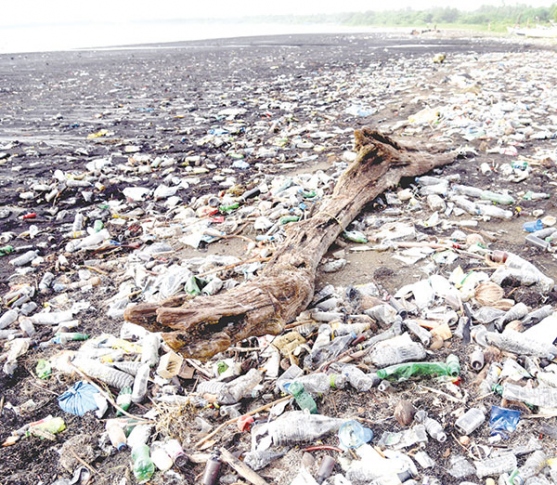
Team Herald
PANJIM: Goa’s well-known beaches are turning toxic. The Goa State Pollution Control Board (GSPCB) has observed that major beaches - Miramar, Calangute, Morjim, Tiracol and Vagator in North and Mobor, Baina, Velsao and Galjibag in South are most polluted with high levels of faecal coliform.
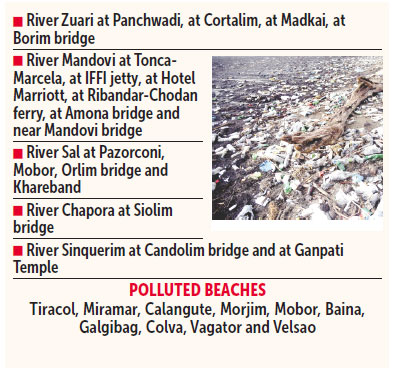
The water quality data analysis for the year 2021-2022, also revealed that State’s major rivers - Mandovi, Zuari, Sal, Tiracol, Chapora and Sinquerim are highly polluted. “Faecal coliform is exceeding the permissible limit as per CPCB classification. In addition, waters at a few of the above locations, at times, indicate non-compliance to the prescribed limits in respect of Biochemical Oxygen Demand (B.O.D.) or pH and hence, in general, water quality at these locations is not satisfactory,” the Board said in its report.
The level of faecal coliform was found to be in the range of 110-790 per 100 ml of water during most part of the study period. The GSPCB study looked at the water quality with respect to major indicators such as biochemical oxygen demand (BOD), dissolved oxygen (DO), faecal matter of humans and other animals (faecal coliform), total dissolved solids (TDS), turbidity and 45 other parameters.
When contacted, a GSPCB official said that various factors can be attributed to the presence of faecal coliform bacteria in the water but the most common is the disposal of untreated or partially treated sewage. “The beaches and rivers are facing a serious threat from pollution and the rapid development,” the official said.
- Goan artistes forced to undertake the craft of activism to save their beloved Kala Academy
- Goa wins five awards at Startup ka Mahakumbh in Delhi
- While main (alleged) protagonist is free, the supporting cast is also released
- 94-year-old Loutolim farmer refuses to walk into the sunset without protecting village lands against the new Borim bridge
- South Goa SP orders inquiry into allegations of assault on woman by Colva PSI

Videos VIEW ALL
First apple farming in goa, idhar udhar.
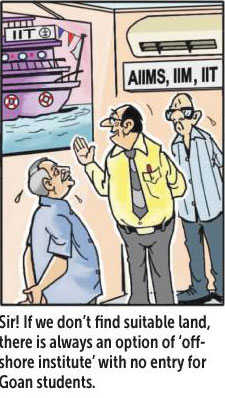

Emission Scenarios and Health Impacts of Air Pollutants in Goa
Sumit Sharma 1 , Kavita Vithal Patil 2
- 1 Centre for Environmental Studies, The Energy and Resources Institute, New Delhi-110003, India
- 2 Coastal Ecology and Marine Resources Centre, The Energy and Resources Institute, Goa- 403202, India
Received: February 2, 2016 Revised: August 5, 2016 Accepted: September 9, 2016 Download Citation: RIS | BibTeX | https://doi.org/10.4209/aaqr.2015.12.0664
- Download: PDF
Cite this article: Sharma, S. and Patil, K.V. (2016). Emission Scenarios and Health Impacts of Air Pollutants in Goa. Aerosol Air Qual. Res. 16: 2474-2487. https://doi.org/10.4209/aaqr.2015.12.0664
This paper presents the first emission inventory for the highly urbanized state of Goa in India, which is an important international tourist destination and also accommodates significant industrial activities, including mining. The observed concentrations of the pollutants like PM 10 and PM 2.5 show violations at many locations. Sectoral inventories prepared in this study depicts mining (38%), industries (24%), and transport (10% tail-pipe and 15% road dust) as the major contributors to the PM 10 emissions in the state. Higher emissions intensity is observed in heavily populated and industrialized coastal taluks and mining dominated taluks. Emissions are projected for the future (2030) under two different scenarios (business as usual and alternative) to assess future air quality and impacts. The grid-wise emissions under these future scenarios are fed into an air quality model, to estimate spatial distribution of PM 10 concentrations in Goa. The model results are validated with actual observations. Thereafter, the grid-wise PM 10 concentrations are overlaid on the population to compute its health impacts using established dose response functions. The study shows that PM 10 accounts for 2.6% of mortalities in Goa, which are expected to go up further in a business as usual scenario. Alternative strategies which show reduction in pollution and associated health impacts in the region are evaluated. Based on the alternative scenario, key recommendations are made for air quality improvement in the state.
Keywords: Emission inventory; Air quality modelling; Health impacts; Goa
Share this article with your colleagues
Other readers also read ...

Read more: ...

Subscribe to our Newsletter
Aerosol and Air Quality Research has published over 2,000 peer-reviewed articles. Enter your email address to receive latest updates and research articles to your inbox every second week.

2023 Impact Factor: 2.5 5-Year Impact Factor: 2.8
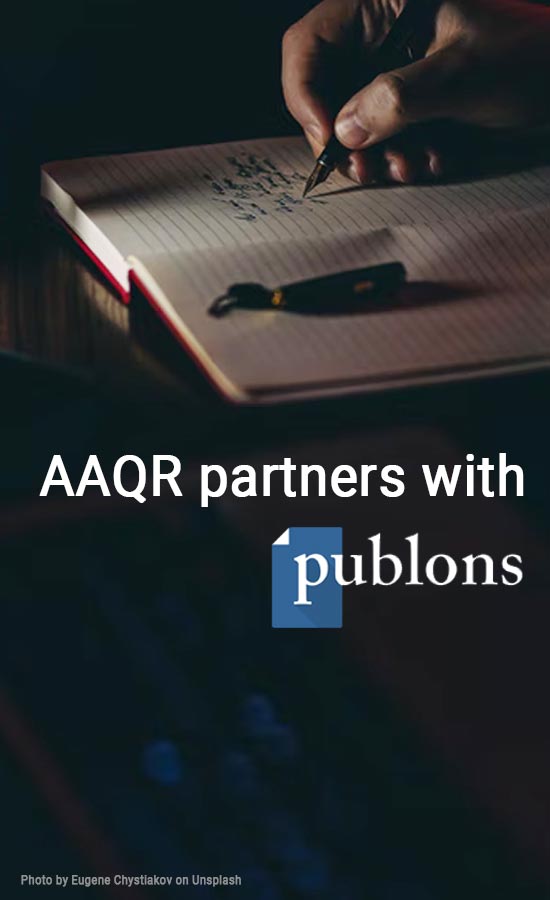
- A Systematic Literature Review of the Impact of COVID-19 Lockdowns on Air Quality in China ( Volume 21, Issue 8, August 2021 )
- Learnings from COVID-19 Forced Lockdown on Regional Air Quality and Mitigation Potential for South Asia ( Volume 22, Issue 4, April 2022 )
- Challenge with a Personal Cascade Impactor Sampler in a Silicon Metal Smelter ( Volume 21, Issue 6, June 2021 )
- A Brief Review on Changes in Air Pollution Scenario over South Asia during COVID-19 Lockdown ( Volume 21, Issue 4, April 2021 )
- Abnormal Respiratory Symptoms of Workers and Sampling of Organic Vapors Using Solid-phase Microextraction Devices in a Golf Ball Manufacturing Factory ( Volume 22, Issue 9, September 2022 )
- Coagulation Characteristics of Nano-agglomerates in Free Molecular States under Different Electric Field Intensities ( Articles In Press )
- Unignorable Emissions and Potential Health Effects of Unregulated Pollutants from Nonroad Engines Using Greener Fuels — A Review ( Articles In Press )
- Rapid Built-up of PM10 in the Ambient Air of the Leeward Side Resulting from Strong Pressure Gradient Force Associated with Density Current ( Articles In Press )
- What Makes the Indian Megacity Chennai’s Air Unhealthy? - A Bottom-up Approach to Understand the Sources of Air Pollutants ( Articles In Press )
- Sub-seasonal Patterns of PM10 and Black Carbon in a Coastal City: A Case Study of Salé, Morocco ( Articles In Press )
You may also like
- Infants’ Neurodevelopmental Effects of PM2.5 and Persistent Organohalogen Pollutants Exposure in Southern Taiwan
- Respirable Crystalline Silica Exposure among Concrete Finishing Workers at Apartment Complex Construction Sites
- Source Identification on High PM2.5 Days Using SEM/EDS, XRF, Raman, and Windblown Dust Modeling
- Comparative Study of PAHs in PM1 and PM2.5 at a Background Site in the North China Plain
- Analysis of PAHs Associated with PM10 and PM2.5 from Different Districts in Nanjing
- PCDD/F Emission from Pharmaceutical Industries
Research Categories
- Diesel Engine Emission
- Bioaerosols
- Control Techniques and Strategy
- Low-Cost Sensors
- Optical/Radiative Properties and Remote Sensing
- CO2 Capture, Storage and Emission
- Nanoparticles
- Aerosol and Atmospheric Chemistry
- Air Pollution Modeling
- Aerosol Physics and Instrumentation
- Physical and Chemical Characteristics of Aerosols
Research Regions
- Middle East
- South America
- South East Asia
- Español (Spanish)
- Français (French)
- Bahasa Indonesia (Indonesian)
- Brasil (Portuguese)
- हिंदी (Hindi)
Goa destroys green cover to enable infrastructure projects
- Goa has seen a systematic destruction of trees, bypassing regulations of the Goa, Daman and Diu Preservation of Trees Act, 1984.
- Thousands of trees at the Mollem National Park and the MOPA airport site, both with hastily passed environment clearances, remain the biggest aggregation of trees facing the axe.
- Due to the different criteria adopted by the Forest Department of Goa and the FSI, large forest areas remained unidentified, which made it easier for town planning authorities to grant permissions for projects.
- As “development” and “lifestyle” repeatedly triumphs the cause of the environment, civil society at large has taken on the responsibility to keep the statutory bodies accountable.
In the Cotigao area in South Goa, it is not an uncommon sight to see women of the village lining up in front of the government water tanker. Five villages in the area, mostly inhabited by the Dhanger community, a nomadic herding tribe, have been facing an acute water shortage – so much so that in the first week of July, members and volunteers with a local environment group, Goa Green Brigade, carried 6000 litres of drinking water to the village from Panjim, the city’s capital about 90 kms away.
“We are soon headed for severe water-wars all over Goa,” notes Avertino Miranda, the founder of Goa Green Brigade.
According to Avertino, “development projects have killed the natural springs, around which most villages are based. The illegal destruction of trees and forest ecosystems have severely impacted the water table in most areas.” Coupled with “linear infrastructure projects, expansion of highways, monoculture, overnight destruction of privately owned forested areas”, Goa’s already fragile eco-system is at a heightened risk.

Last year, Goa saw huge protests as six iconic mango trees, most of which were over 200 years old, were felled overnight for a highway expansion project in Colvale, even after the chief minister and the PWD had assured citizens otherwise. As of July 2020, a notification issued by the State Town and Country Planning (TCP) department includes nearly 400,000 (4 lakh) sq m of orchard land, 49,000 sq m of land classified as natural cover, as well as another 1,07,000 sq m of paddy fields and orchards are reportedly to be diverted for 112 project proposals which recently ended the public consultation period.
Earlier this year the Supreme Court cleared the Mopa airport project which sanctioned the felling of 55,000 trees posing a risk to 42 natural springs in the area, besides two wetlands, mangroves and 10 ecologically sensitive areas notified by the Ministry of Environment, Forests and Climate Change (MoEF&CC).
Abhijeet Prabhudesai, co-founder of Rainbow Warriors, an ecological outfit that has been working to protect Goa’s forests, notes that while 55,000 is only the official number, he claims that over 200,000 trees have been axed in the area. Amongst many other peculiarities, he also points to a “shoddy” environment impact assessment (EIA) – given that the EIA consultant for the project was the same independent engineering firm contracted to oversee the construction of the airport.
The case of three major infrastructure projects sanctioned through the Mollem National Park, followed a similar trajectory – the projects which would in effect, divert a total of 250 ha of forest land for commercial purposes, 170 ha of which falls within protected areas – were sanctioned via video conference in April this year. Several members of the Goa State Wildlife Advisory Board later in a letter to the Wildlife Warden noted the “hasty and unstructured nature of the meeting”, and also raised an alarm at the fact that the projects were proposed by the Forest Department, rather than the project proponent themselves.
Anamika Gode, an environmental lawyer, notes that “an area when notified as a protected area, brings with it immense statutory protection. Diversion of such forest land is only allowed if it will benefit the wildlife population or their habitat. While infrastructure projects have historically been allowed, citing MoEFCC guidelines that enable human-centric development in the “most exceptional of circumstances”, it must be kept in mind that these guidelines cannot, under any circumstances, circumvent the law.”
Bypassing laws
India’s forestry policy, according to the Forest Conservation Act of 1980, is oriented towards “conservation” – the law governs all diversions of forest areas for non-forest purposes – under which permissions for tree fellings are to be obtained through a rigorous set of processes – project proposals are to go through six different levels of scrutiny by officials appointed by the state and Central Boards of Forestry, based on which the project is either recommended ahead or rejected. A similar set of processes mandate wildlife clearances. The decisions are based on Environment Impact Assessment reports, which, have come under fire for sidestepping due process.
The initial EIA for the Mopa airport falsely stated that there are no forest, lakes, mountains, ecologically sensitive areas, rivers or wild flora and fauna within a radius of 15 kilometres from the airport site, and later doubled back on the same (noting four rivers, 42 reserve forests, two wetlands, mangroves and 10 ecologically sensitive areas notified by the MoEF&CC). Despite this blatant misrepresentation, the project was cleared by the SC citing “a balance of environment and development” in the Mopa judgement.
In the case of Mollem, despite the fact that the project “bifurcates the entire landscape” of a UNESCO-tagged “global biodiversity hotspot”, for the purpose of clearances, the mega grid has been broken down into “piecemeal, low-impact projects”, instead of assessing the project as a “cumulative” whole. The EIA report is riddled with irregularities – to cite an example, one of the projects – the expansion of the National Highway NH4A from 84 km to 153 km, for which 20,199 trees are scheduled to be felled, was approved despite the fact that of the 33 ha of land inside the Mollem National park that is to be diverted, noted the site report, only 11 ha was inspected by the forest department.

According to Sreeja Chakraborty, environmental lawyer, “The forest department claims that the rest of the area will be used for peripheral activities like building approach roads, and that they will retreat from the area once the project is completed. It’s a rubbish excuse, because in the 4-5 years that it will take them to complete the project the ecology of the area will be completely destroyed.”
After multiple red flags raised by several individual and environmental outfits, the MoEF&CC has only now sought “additional details” pointing out that GTTPL, an SPV allotted to Sterlite Power has “not sufficiently explained” this in the company’s application, which says “35% of trees only are required to be actually felled out of enumerated trees” .
Chakraborty points to several other irregularities, including the bypass of the compensatory afforestation (CA) laws – one of the most important prerequisites for approvals from the Centre which assures “compensating the loss of ‘trees by trees’”. The provisions further specifically state that CA shall be raised and maintained at the cost of the user agency twice in the extent of the forest area diverted, in case of transmission lines or road expansion. Despite this, Section 13 of the project proposal through Mollem, lists “Not applicable” against the requirement – “Copy of CA scheme details”. “Each of these processes have a lot of significance but they have reduced it to nothing but a rubber stamp formality”, notes Chakraborty.
According to environmentalist Abhijeet Prabhudesai, CA in the state has been problematic to begin with. In the past 10 years, since Goa failed to meet any of the targets for compensatory afforestation the MoEF&CC has stopped allocating funds to Goa under the Compensatory Afforestation Management and Planning Authority. Prabhudesai further notes that in several instances areas deigned by the state for CA purposes, when inspected by his team revealed to be “already heavily forested – including areas in Chorao island and Sanguem taluka, some with almost a 100% foliage”. In yet another instance, he notes, “The government gave out seeds during the Van Mahotsav (a national tree plantation drive) and called that compensatory afforestation.”
Taking a cue from these gross infractions inside protected areas, privately owned lands have also seen a major illegal destruction of trees. Under the Goa, Daman and Diu Tree Protection Act 1984 no person can fell, or remove a tree whether in his occupancy or ownership or otherwise, except with previous permission from a designated tree officer. Despite this the tree cover (which refers to small patches of less than 1 ha, including scattered trees) has seen severe destruction over the last couple years.
In October, 2019, in Assagao, a village in North Goa, 47 mature trees were felled illegally overnight. Several such incidents have been reported in Merces, Siolim and several other areas across North and South Goa . This poses a significantly major threat, particularly because Goa is in a unique position where private forest ownership contributes to the green cover, though a large part of it is not yet notified .
Altering the definition of a tree
According to a case filed by Goa Foundation in 2013, the Goa State government refused to recognise about 1000 sq kms of land as forest land – a discrepancy due to the different criteria adopted by the Forest Department of Goa and the Forest Survey of India. While the case is still pending with the National Green Tribunal, in 2016, the state made yet another amendment to the Goa, Daman & Diu Tree Protection Act, that has further enabled tree felling – the definition of a tree was altered to mean “a woody plant whose trunk is not less than 10 cm in diameter at a height of 1 m from the ground”, as opposed to its earlier definition “a woody plant whose trunk was not less than 5 cm in diameter at a height of 30 cm from the ground.
Thus, it is no surprise that the Indian Forest Survey’s state of forest report of 2019, already noted a loss of 51 sq kms of tree cover as compared to the 2017 report, a situation which has only worsened since, citing the necessity to “balance development with environment.”

According to Prabhudesai, “Most of the projects sanctioned through the last few years, are infrastructure projects mandated by either the state or centre, without any benefits to the people.” Avertino Miranda notes that “these big projects have caused severe negative impact on the trees and Goa’s rich biodiversity only to facilitate the cause of big corporations – the road expansion, transmission lines being built through Mollem are mainly to facilitate movement of coal by the Adani group.” Both particularly point to the counter-productive nature of such decisions, given the rise of zoonotic diseases.
Environment policy and zoonotic diseases
According to a study of the Kyasanur Forest Disease (KFD), also commonly known as monkey fever – zoonotic diseases disproportionately affect poor tropical communities, accounting for around 26% of Disability-adjusted Life Years (DALY) lost to infectious diseases in lower middle income countries. The study further notes that “recognising the interconnectedness of human health, wildlife and domestic animal health and the environment” can help facilitate the prediction and prevention of such diseases, and help shape environment and development policymaking.
Read more: Environment ministry unlocked many protected areas during the lockdown
Nandini Velho, an independent researcher who has also worked in environmental policy, notes that given we are living through a pandemic, this is a time when environment policy making needs to be further strengthened. “An ear-to-the-ground approach is the need of the hour. Before we can indulge in the debate of ‘environment versus development’ at least due process needs to be followed.”
In Goa, as “development” and “lifestyle” repeatedly triumphs the cause of the environment, civil society at large has taken on the responsibility to keep the statutory bodies accountable. But with major infractions happening time and again, environmentalists fear that Goa’s crisis is only beginning.
Banner image: Tree felling in Siolim. Photo by Mohan Kumar, Living Heritage Foundation.
Special series
Wetland champions.
- [Commentary] Wetland champions: Promise from the grassroots
- The story of Jakkur lake sets an example for inclusive rejuvenation projects
- Welcome to Tsomgo lake: Please don’t litter
- Managing waste to save the wetlands of Himachal Pradesh

Environment And Health
- As cities become megacities, their lanes are losing green cover
- Marine plastic pollution is not just a waste problem; reducing production is needed too
- Stitching sustainability amidst climate change challenges
- Gujarat bans exotic Conocarpus tree amid health and environment hazard

Almost Famous Species
- Study finds leopard cats and red foxes cohabit regions in the Western Himalayas
- Civet latrines in the shade puzzle researchers
- Small cats’ ecology review flags declining conservation status
- [Explainer] How are species named?

- [Video] Flowers of worship sow seeds of sustainability
- Rising above the waters with musk melon
- Saving India’s wild ‘unicorns’
- Crafting a sustainable future for artisans using bamboo

India's Iconic Landscapes
- Unchecked shrimp farming transforms land use in the Sundarbans
- [Commentary] Complexities of freshwater availability and tourism growth in Lakshadweep
- Majuli’s shrinking wetlands and their fight for survival
Beyond Protected Areas
- Otters face heat from smugglers in northeast India
- The hispid hare’s habitat in Himalayan grasslands is shrinking fast
- What’s on the menu? Understanding the diverse diet of fishing cats


Conserving Agro-biodiversity
- Kashmiri willow steps up to the crease and swings for recognition
- Rising temperatures alter insect-crop interactions and impact agricultural productivity
- Pricey guests: Urban invasive species cost the world billions every year
- [Commentary] GROW with agroforestry, a step towards sustainable land management

Just Transitions
- [Interview] “This is in honour of adivasis fighting for their land, water, forest,” says Goldman Prize winner Alok Shukla
- How unplanned coal mine closures in India are affecting dependent communities, especially women
- Green Credit Scheme’s ‘methodology’ doesn’t inspire confidence among experts
- Conflict over critical mineral prospecting in Odisha signals need for better community involvement

Sewage Treatment and Management in Goa, India: A Case Study
- Original Paper
- Published: 23 November 2015
- Volume 8 , pages 67–77, ( 2016 )
Cite this article

- A. Singh 1 ,
- A. Kazmi 2 ,
- M. Starkl 3 ,
- I. Bawa 4 ,
- P. Khale 4 ,
- V. Patil 5 ,
- I. Nimkar 6 &
- M. Naik 6
864 Accesses
6 Citations
Explore all metrics
Water pollution in India is primarily associated with unmanaged urbanization, population explosion, inadequate capacity of sewage treatment, and its disposal, which lead to unhygienic and insanitary conditions. This paper gives an overview on sewage treatment plants (STPs) in Goa—a coastal state in India. Being a famous tourist destination, it is important to monitor and control water pollution levels in Goa state, so as to safeguard the health of tourists and thereby the economy of the region. The capacity-wise distribution of STPs was mapped against regional population distribution and drainage system of Goa using ArcGIS. This information will be very useful for further analysis of the allocation of STPs and its adequacy with regard to the population. A majority of STPs at Goa are managed by private authorities like hotels and resorts. Four municipal plants under Goa Public Works Department were evaluated.
This is a preview of subscription content, log in via an institution to check access.
Access this article
Subscribe and save.
- Get 10 units per month
- Download Article/Chapter or Ebook
- 1 Unit = 1 Article or 1 Chapter
- Cancel anytime
Price includes VAT (Russian Federation)
Instant access to the full article PDF.
Rent this article via DeepDyve
Institutional subscriptions
Similar content being viewed by others
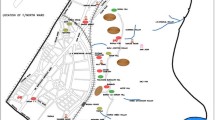
Impact of Redevelopment Projects on Waste Water Infrastructure
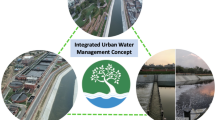
River rejuvenation in urban India for enhancing living conditions through integrated water resources management

Remediation of Contaminated Urban Streams: A Decentralized Ecological Wastewater Treatment Approach
Abood AR, Jiangkun DJB, Zheng YLD (2014) Non-biodegradable landfill le achate treatment by combined process of agitation, coagulation, SBR and filtration. Waste Manag 34:439–447
Article CAS Google Scholar
Arnold E, Bohm B, Wilderer PA (2000) Application of activated sludge and biofilm sequencing batch reactor technology to treat reject water sludge dewatering systems: a comparison. Water Sci Technol 41:115–122
CAS Google Scholar
Benujah BR, Devi G (2013) Site suitability evaluation for sewage treatment plant in Nagercoil municipality, Tamil Nadu using remote sensing techniques. Available at http://www.nrsc.gov.in/pdf/ben.pdf
Borker DJS (2013) Sewerage scenario in the state of Goa. Public Works Department, Government of Goa
Bunch MJ, Kumaran TV, Joseph R (2012) Using geographic information systems (GIS) for spatial planning and environmental management in India: critical considerations. Int J Appl Sci Technol 2(2):40–54
Google Scholar
Burrough PA, McDonnell Rachael A (1998) Principles of geographical information systems. Oxford University Press, New York
Census Info India (2011) http://www.devinfolive.info/censusinfodashboard/website/index.php/pages/sanitation/total/Households/IND . Accessed 18 November 2011
Census info India (2014) Census data online. Available at http://censusindia.gov.in/2011-common/censusdataonline.html
Central Pollution Control Board (CPCB) (2005) Status of sewage treatment in India. http://www.cpcb.nic.in/newitems/12.pdf
Commission (2011) Goa Development Report, Government of India
Department of Tourism Government of GOA (2011–2012) Annual administration report for the year 2010–2011
Department of Tourism Government of GOA (2012–2013) Annual administration report for the year 2012–2013
Ding D, Feng C, Jin Y, Hao C, Zhao Y, Suemura T (2011) Domestic sewage treatment in a sequencing batch biofilm reactor (SBBR) with an intelligent controlling system. Desalination 276:260–265
ENVIS Centre (2012) National status of waste water generation & treatment. Sewage Treatment Systems and Technology, Ministry of Environment and Forests Sanitation. http://www.sulabhenvis.nic.in/Database/STST_wastewater_2090.aspx . Accessed 20 November 2013
The Environment (Protection) Rule (1986) Available at http://jkforest.gov.in/act/Environment_Protection_Rules.pdf
Gieseke A, Arnz P, Amann R, Schramm A (2002) Simultaneous P and N removal in a sequencing batch biofilm reactor: insights from reactor- andmicroscale investigations. Water Res 36:501–509
Government of Goa, Department of Tourism, About Goa. http://www.goatourism.gov.in/ . Accessed 21 November 2013
IL&FS Infrastructure (2012) Identification of tourism circuits across India, interim report Goa
Indian Sanitation Portal (2013) Sanitation programme makes slow headway in rural Goa. http://indiasanitationportal.org . Accessed June 25 2013
Jamwal P, Mittal AK (2010) Reuse of treated sewage in Delhi city: microbial evaluation of STPs and reuse options. Resour Conserv Recycl 54:211–221
Article Google Scholar
Kamyotra JS, Bhardwaj RM (2011) Municipal wastewater management in India. Available at http://www.idfc.com/pdf/report/2011/Chp-20-Municipal-Wastewater-Management-In-India.pdf
Martin-Cereceda M, Serrano S, Guinea A (1996) A comparative study of ciliated protozoa communities in activated sludge plants. FEMS Microbiol Ecol 21:267–276
McCarty PL, Brodersen CF (1962) Theory of extended aeration activated sludge. J Water Pollut Control Fed 34:1095–1103
Middlebrooks and Gardland (1968) Kinetics of model and field extended-aeration wastewater treatment units. J Water Pollut Control Fed 40:586–612
Ministry of Environment and Forests (MoEF) (2011–2012) Performance audit of water pollution in India. Comptroller and Auditor General of India Report No. 21
Morrison EM, Motter K, Baxter K (2004) Quality assurance plan. Willamette Research Station Analytical Laboratory, Water Chemistry Laboratory Manual. http://water.epa.gov/type/rsl/monitoring/upload/2005_03_14_monitoring_wsa_WRS_lab_manual.pdf . Accessed 24 Feb 2013
Patil JA, Kulkarni SS (2012) Design and mapping of underground sewerage network in GIS, a case study of Islampur Town. Int J Sci Res 3(8):2319–7064
Public Works Department (PWD) GOA (2005) Review on water supply and sanitation programmes, CHAPTER-III performance reviews
Report of Golden Jubilee Development Council (2012) GOA 2035: vision and road map. Available at http://dhe.goa.gov.in/GGJDC_Report.pdf
Sarti A, Fernandes BS, Zaiat M, Foresti E (2007) Anaerobic sequencing batch reactors in pilot-scale for domestic sewage treatment. Desalination 217:174–182
Sewage Business Management Centre (2015) Available at https://www.sbmc.or.jp/english/index.html
Sewage & Infrastructure Development Corporation of Goa Ltd. (SIDCGL) (2013) Status of sewage treatment plants in the state of Goa. http://www.sidcgl.com/aboutus.php . Accessed 19 November 2013
Tyagi VK, Subramaniyan S, Kazmi AA, Chopra AK (2008) Microbial community in conventional and extended aeration activated sludge plants in India. Ecol Ind 8:550–554
Van Haandel A, Lettinga G (1994) Anaerobic sewage treatment. Wiley, New York
Von Sperling M, Chernicharo CAL (2005) Biological wastewater treatment in warm climate regions. IWA Publishing, London
Wilderer PA, Roske I, Ueberschar A, Davids L (1993) Continuous flow and sequenced batch operation of biofilm reactors: a comparative study of shock loading responses. Biofouling 6:295–304
Wu GX, Michael N, Ketil S, Zhan XM, Michael R (2009) Distributions and activities of ammonia oxidizing bacteria and polyphosphate accumulating organisms in a pumped-flow bio-film reactor. Water Res 43:4599–4609
Download references
Acknowledgments
The work presented in the paper has been supported by the Department of Science and Technology and European Union, Project Supporting consolidation, replication and up-scaling of sustainable wastewater treatment, and reuse technologies for India (SARASWATI).
Author information
Authors and affiliations.
Industrial Safety and Environmental Management, National Institute of Industrial Engineering (NITIE), Mumbai, India
Department of Civil Engineering, Indian Institute of Technology (IIT), Roorkee, India
Competence Centre for Decision Aid in Environmental Management, University of Natural Resources and Life Sciences (BOKU), Vienna, Austria
Supporting Consolidation, Replication and Upscaling of Sustainable Wastewater Treatment and Reuse Technologies in India (SARASWATI), National Institute of Industrial Engineering, NITIE, Mumbai, India
I. Bawa & P. Khale
National Institute of Industrial Engineering, NITIE, Mumbai, India
Centre for Environnemental Studies (CES), National Institute of Industrial Engineering, NITIE, Mumbai, India
I. Nimkar & M. Naik
You can also search for this author in PubMed Google Scholar
Corresponding author
Correspondence to A. Singh .
Rights and permissions
Reprints and permissions
About this article
Singh, A., Kazmi, A., Starkl, M. et al. Sewage Treatment and Management in Goa, India: A Case Study. Expo Health 8 , 67–77 (2016). https://doi.org/10.1007/s12403-015-0183-5
Download citation
Received : 27 July 2015
Revised : 28 October 2015
Accepted : 28 October 2015
Published : 23 November 2015
Issue Date : March 2016
DOI : https://doi.org/10.1007/s12403-015-0183-5
Share this article
Anyone you share the following link with will be able to read this content:
Sorry, a shareable link is not currently available for this article.
Provided by the Springer Nature SharedIt content-sharing initiative
- Find a journal
- Publish with us
- Track your research
- Climate Change
- Uncovering Hate
- Manipur: A Year On
- Members Only
- Brand Studio
- Entertainment
- The Quint Lab
- Graphic Novels
- HOPE Series
- South Asians
- Members' Opinion
- Privacy Policy
BECOME A MEMBER
Water crisis, loss of livelihood for villages in goa’s mining belt, mining activity may have shut down but mines have been abandoned without restoration in several goan villages..
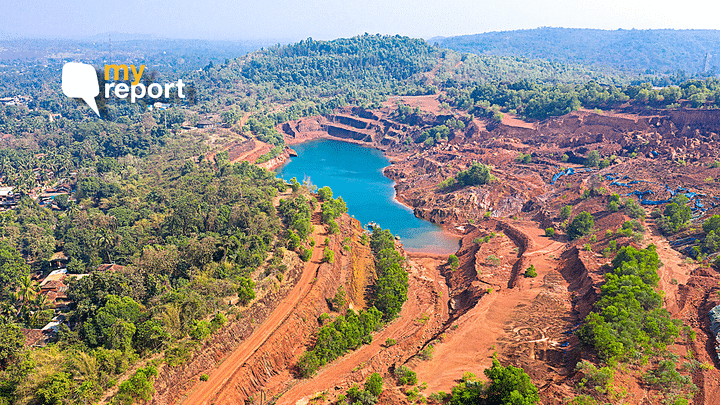
Since 2014, I have been living a part of the year in Goa. The 2018 floods of Kerala was a wake-up call to the regions along the Western Ghats. It sounded the alarm against the vulnerabilities of an ancient ecosystem. It pushed me to study the impact of human activities on Goa's delicate water ecosystem. As a part of the research, I studied the effects of mining on the availability of ground and surface water and its long-term effects on the climate.
Goa is a coastal state and faces water issues due to climatic extremes like tidal erosion and depression. However, humans’ ‘development activities’, like mining, tourism, and mega-housing projects in catchment areas, have escalated these troubles.

Hilly midlands in Goa are rich in iron ore and manganese ore and mining these have wreaked havoc on the rich biodiversity of the state. This is fuelled by a lack of adequate monitoring and control mechanisms.
A shot of Pissurlem Village shows how the forest cover was removed for mining.
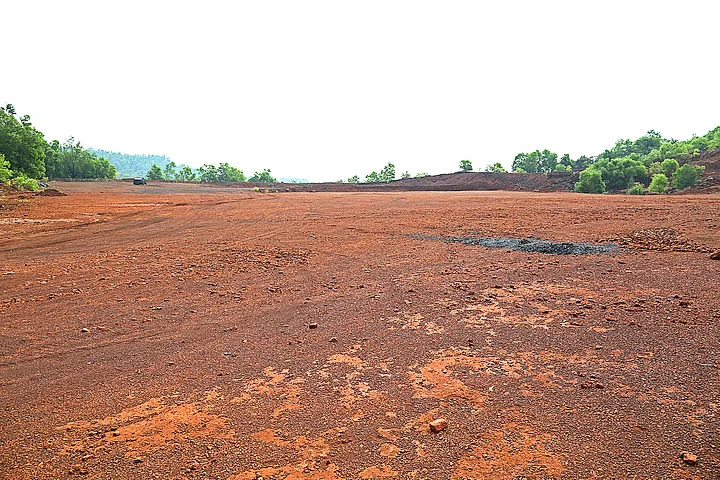
Further, mining for iron has created many irreversible environmental issues, that are exacerbated by the removal of vegetation and topsoil, and mountains of landfill waste. Deforestation, climatic change, soil erosion, air and water pollution are suffered by the local population as a consequence.
Additionally, this increases overall temperature and affects the rainfall pattern, too. “Destruction of forest cover is changing the weather condition dramatically here in Goa,” says Ramesh Gauns, a pioneering mining and environment activist.
There has been ample research (TERI, 1998 and NEERI, 2009) on the effects of mining activities on the river-water quality. Deepening mines below groundwater level has resulted in loss of recharge area of wells and springs, thereby affecting groundwater availability in many areas.
At a mining pit at Shirgao Village, mining activity was shut down and mine abandoned without closing the pit after a Supreme Court order in 2018. The wells of Shirgao village are dry and groundwater collects in the mine, but it is of no use to the villagers as the impounded water is sterile and biologically dead.
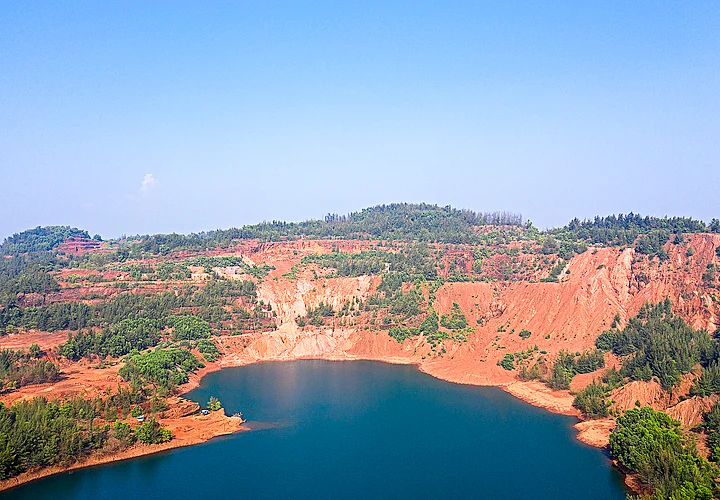
Similarly, the Bicholim mine site was abandoned without restoration according to Mine Closure Policy of 2003. On the left of the pit lie mounds of mining waste.
The wells of Bicholim Village have dried up and waterbodies are still polluted. As a result, Bicholim town and neighbouring villages are as thirsty as they were while the mines were operational.
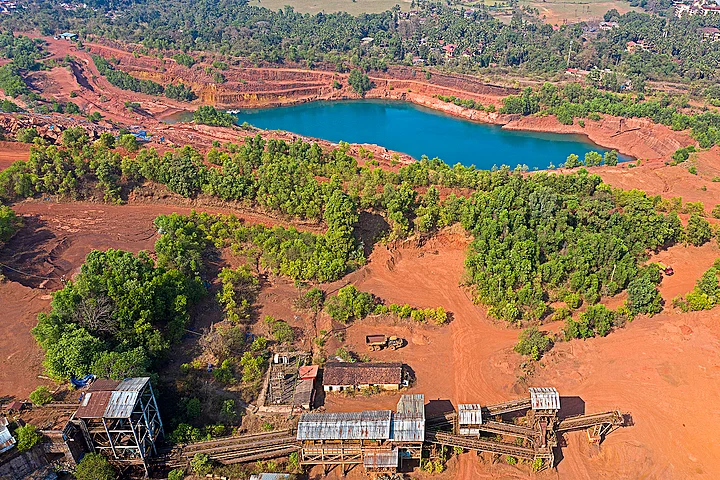
How are waterbodies polluted due to mining? An aerial view of the landfill of the Bicholim mine is self-explanatory. Mining waste is piled at a slope steeper than 30 degrees, which during monsoon time, makes its way into water bodies and fields.

In the following picture, mounds of mining waste are visible on the right. On the left lies Lamgaon Village and its farms, waiting for water to be made available for irrigation. Once famous for cashew nut and betel nut plantations, this area has its fields flooded with silt since the floods of 2000. Villagers have long lost their livelihood and still await their compensations and de-siltation of fields.
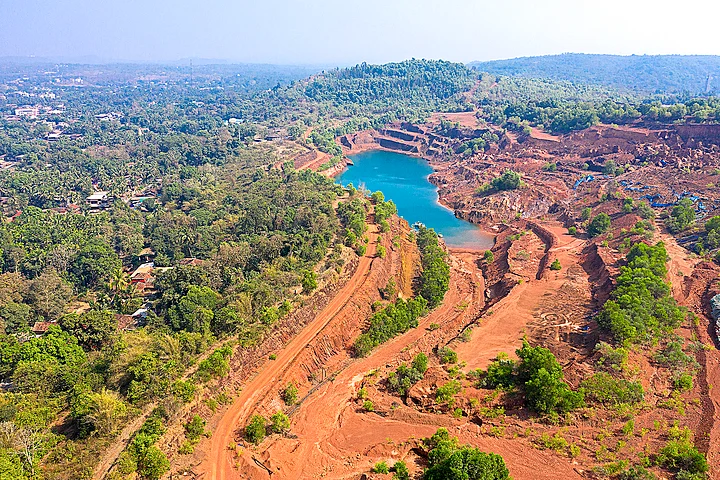
Soil Infertility and Acidic Discharge
The acidic discharge from the mining pits and mining-waste heaps is called acid mine drainage. Toxic metals drain into water bodies during monsoon run-offs. Acid mine drainage is impossible to stop once it begins and can cause indefinite damage to water sources and soil.
Anti-mining activist Hanumant Parab from Pissurlem, who wants to start farming in his village, says this silted soil has lost its fertility and water-holding capacity. Since the floods of 2000, fields have become infertile and fallow. No cultivation of these lands has been possible since then.

For growing paddy, the fields are usually filled with water just before the monsoon to allow the seeds to germinate. Later, this extra water is channelled to the streams. Now, the fields in the vicinity of mines remain waterlogged and the germinated seeds rot, destroying the paddy crop.
Sustainable mining requires mining industries to respect and appreciate the need and value of biodiversity the local people living in mining zone have. They need to work within the given law.
“De-silt and restore the lake and other water bodies. De-silt our farms according to the law. Give us our livelihood back. We have no problem if mines work in accordance to the law, but first restoration of the damage done must be fulfilled.”
For example, a freshwater lake, which supplied water to the Pissurlem, was fed by a perineal natural spring that dried up two decades ago as the flow of water was cut off by mining activity.
As the mining activity continued below groundwater level, all wells and springs dried up. The lake can be seen contaminated with mining waste, mining silt and weeds.
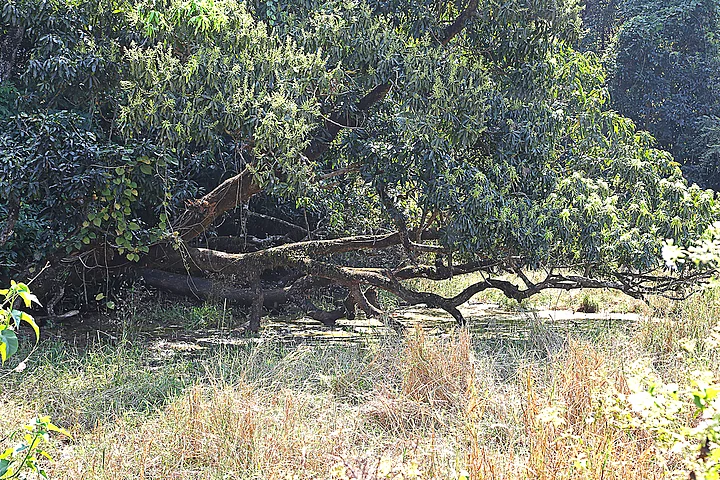
Other mining pits at Pissurlem have had the same fate. Deulem mining pit’s rehabilitation, reclamation and land restoration are still pending. The same is the case for Gulliem and Gaval mines. Meanwhile, villagers of Pissurlem try and find solutions to the grave water crisis they live in every day.
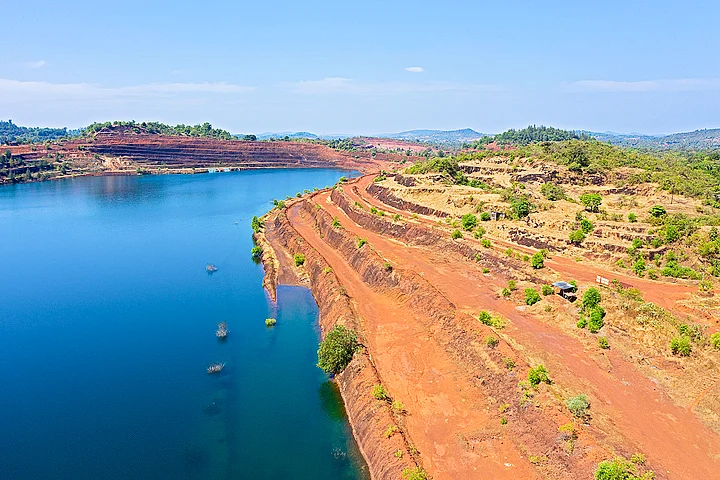
Around Gulliem and Gaval mines, mother nature is claiming back what belongs to her. The green cover is returning wherever possible.
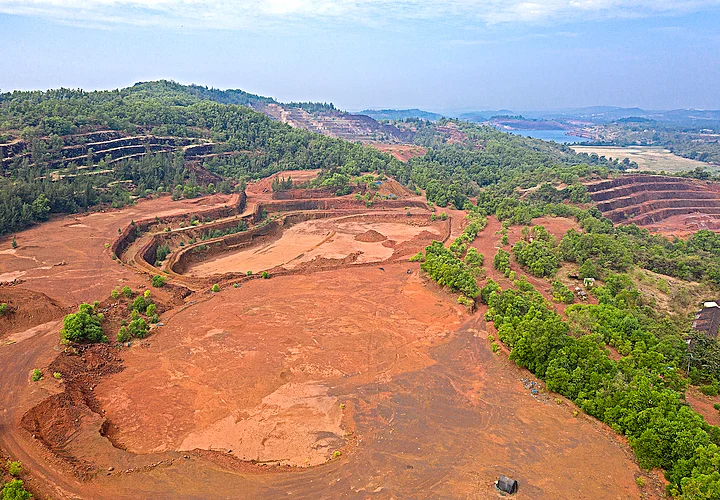
“In Shirgaon, 76 wells have gone dry and in Pissurlem, 80 wells have dried up. Hundreds of springs have gone dry in the mining belt. Fertile paddy fields have turned into a wasteland due to siltation and overburden runoffs. There has been no cultivation possible here for more than 15 years,” notes Ramesh Gauns.
The village of Shirgao won a court case at the Bombay High Court after 12 long years. The Court directed the District Mineral Foundation, Vedanta, Chowgule and Timblo to pay a sum of 40 million rupees for restoring the fields. The drainage network was de-silted using heavy machinery. This has given hope to the other villages fighting for the same cause.
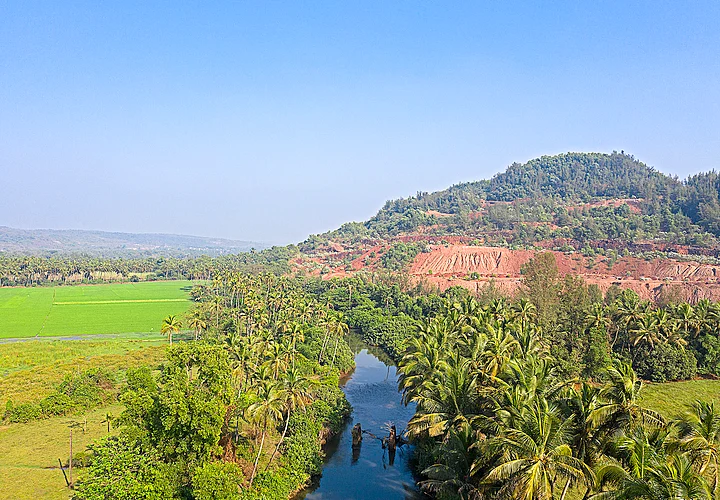
In addition to green pastures, de-silted and restored channels of the river are lined with an array of green coconut trees in Shirgao today. The old temple, built on the edge of the mining pit, no longer witnesses trucks loaded with ore, going up and down the roads.
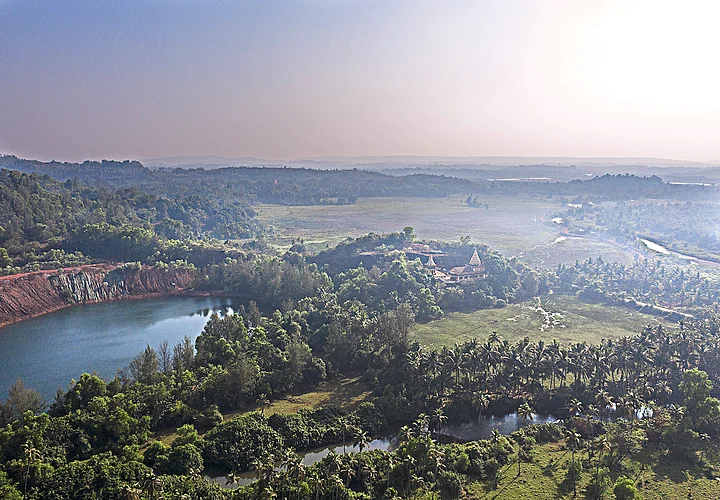
On the contrary, there is a mad rush of the barges carrying iron ore to the docks via Mandovi river, as iron ore seeks an all-time high price in international markets. This is a reminder that there is lot left to be achieved.

“Where ever there is a mine, there is destruction and deforestation,” Gauns concludes.
(The author is a fine arts photographer based in Delhi. All 'My Report' branded stories are submitted by citizen journalists to The Quint . Though The Quint inquires into the claims/allegations from all parties before publishing, the report and the views expressed above are the citizen journalist's own. The Quint neither endorses, nor is responsible for the same.)
( At The Quint, we are answerable only to our audience. Play an active role in shaping our journalism by becoming a membe r . Because the truth is worth it. )
Read Latest News and Breaking News at The Quint, browse for more from my-report
Topics: goa climate change water crisis .
Loading Comments...
Academia.edu no longer supports Internet Explorer.
To browse Academia.edu and the wider internet faster and more securely, please take a few seconds to upgrade your browser .
Enter the email address you signed up with and we'll email you a reset link.
- We're Hiring!
- Help Center

The Role of Purity and Pollution Rituals in Religious Conversions of Goa during Portuguese Colonization: a Probe through Select Goan Novels

2022, Interventions: International Journal of Postcolonial Studies
Related Papers
Interventions, Taylor Francis Q1 JOURNAL
Colonial period of Goa, a small southwestern state of India colonized by Portugal for over 450 years, is often looked at as a period of pollution and impurity. This article seeks to understand the role of purity and pollution rituals in the religious conversions of the sixteenth century. We undertake to closely analyze the fictionalized instances of conversions in the select novels, and draw from references from historical documents. The article combines socio-literary and historical approaches to the subject to present a broader tapestry of the religious upheavals that took place in Goa mainly in the sixteenth century.
Pius Malekandathil
Shail Mayaram
Book Review
Ângela Barreto Xavier
Golden Lotus
Pallottine Call
Maria Dhanaraj ThivyaRajan
A Book Recommendation: Recently I came across a novel purely by a chance. As I was looking for details into the Portuguese occupation of Goa, the Google presented me a link to a novel that dealt with the theme. I could not restrain myself. Immediately placed an order for it and upon its arrival I gulped it down in three days. The novel was originally written in Konkani using the Devanagari script by the Karwar born writer Mahabaleshwar Sail. The novel is titled Yug Sanvar in Konkani and its English title is Age of Frenzy. There is also a Marathi translation done by the author himself. It is titled as Tandav. The English translation is superbly rendered by Vidya Pai. I would recommend this novel firstly to members of all the Konkani community irrespective of the religion one adheres to. For the Konkani Christians, this novel can be a travel back to their roots, a peep into the moment when their ancestors embraced Christianity. For the Konkani Hindus, this novel is a testament to their staunch faith and the resultant migration to various parts outside of Goa to escape the Portuguese religious policy. The recommendation does not end with these two. It is also for all-for all Catholics to understand the church history in India; for everyone to understand the tensions as two religions/cultures come to a clash. The Plot: The novel is situated in a fictional Goan farming village Adolshi. The village is socially stratified into Brahmin settlements, Nayak (Kshatriya) settlements and the settlements for other castes and untouchables (Maher community). The dominant ones are naturally the Brahmin and the Nayak communities. The Brahmins have their own temple and their own rituals. The Nayaks have their own God and religious practices. The deity of Nayaks is considered the Gramdev (the village deity of Adolshi) and there is a big and a magnificent temple in which the idol is housed. There are very many small deities with their small shrines scattered all over the village. The dominant communities own most of the agricultural tracts and the orchards and the members of other communities help in their fields. The life is normal till the 1510 when the Portuguese arrive in Goa.
Tensing Rodrigues
This book is about Afonso de Albuquerque’s grand dream of creating in Asia a community of people who would be loyal to the Portuguese crown not just politically, but emotionally as well. Albuquerque had conceived a three pronged attack on Goanidentity : conversion to Christianity, annihilation of the native language and the mixing of the blood. Once these three roots of identity - religion, language and race - were severed, Albuquerque expected Goans to be a lost people, naturally gravitating towards a Portuguese identity.
Indo Nordic Author's Collective
Dr. Uday Dokras
History of Christianity in Goa
Loading Preview
Sorry, preview is currently unavailable. You can download the paper by clicking the button above.
RELATED PAPERS
Ines G. Zupanov
Alexander Henn
Jews of Goa, edited by Shalva Weil
Joaquim Rodrigues dos Santos
Revista Brasileira de História, 43, 92, p. 199-216
José Pedro Paiva
The Jews of Goa
DEJANIRAH COUTO
Norms beyond Empire Law-Making and Local Normativities in Iberian Asia, 1500-1800, Bastias Saavedra, M. (Eds.), Leiden: Brill
Patricia Souza de Faria
Journal of Asian Ethnology
Chad Bauman
Cláudia Pereira
Nidān: International Journal for Indian Studies
Jason Fernandes
Patrimónios Contestados
Amita Kanekar
The Making of the Luso-Asian World: Intricacies of Engagement
Everton V. Machado
ACT 27 - Goa Portuguesa e Pós-Colonial: Literatura, Cultura e Sociedade, Everton V. Machado and Duarte D. Braga (Eds.)
Susheel K Sharma
Teotonio R. de Souza
CES Contexto Debates
Kaustubh Naik
Ler História
Timothy Walker
Kritika Kultura
Jason Fernandes , Paul Melo e Castro
Miguel Rodrigues Lourenço
Archivum Historicum Societatis Iesu
Bradley T Blankemeyer
RELATED TOPICS
- We're Hiring!
- Help Center
- Find new research papers in:
- Health Sciences
- Earth Sciences
- Cognitive Science
- Mathematics
- Computer Science
- Academia ©2024

Solid waste management in Goa: The way forward
Introduction.
Poor waste management can affect not just the aesthetic beauty of the environment, but can severely impact 'a valuable resource base', its ecological functions and thus, the health of the environment. With the rise in population, both residential and floating, and the consequent increase in waste generation, the problem will only get compounded in the years to come. This thus calls for effective waste management practices to be followed at all levels across the state.
The Government recently notified the new Solid Waste Management Rules 2016 replacing the Municipal Solid Waste (Management and Handling) Rules of 2000. These rules are now applicable beyond municipal areas to include urban agglomerations, census towns, notified industrial townships, areas under the control of Indian Railways, airports, airbase, port and harbour, defence establishments, special economic zones, State and Central government organizations, places of pilgrims, religious & historical importance as well. The new rules also empower local urban bodies to charge for waste collection and disposal along with spot fines for littering.
As a waste generator, it is important to prioritize waste reduction at source as the first best practice option available. The well-established waste management principles strongly advocate waste minimization as the first step as it drastically reduces the amount of resources and infrastructure needed in the whole waste management process. Door-to-door collection systems should be put into place so as to collect segregated waste and avoid any waste especially mixed waste going into common waste receptors. The next best option in the waste management hierarchy is 'segregation at source'. This is strongly encouraged as it retains waste in its best form possible and thus helps in achieving optimum composting and recycling rates. Decentralized (and centralized, where not possible) composting should be undertaken to recycle the biodegradable component into manure. This will divert at least 40-50% of the total waste being sent for disposal and therefore shrink all related operational costs.
On 30 May 2016, Goa's 30th Statehood Day, a Solid Waste Treatment Plant (with a total capacity of 100 tonnes per day) was inaugurated at Saligao. The plant has been planned as a state-of-the-art modern facility based on mechanical biological treatment (MBt) process with proper segregation, recovery of recyclables and bio-methanation process. It thus has three major components: a material segregation and recycling center, bio methanation and composting section, and a scientific secured landfill. Considering the plant has been in operation only for a few months, a fair evaluation of its performance can be done only after a sustained period of time.
As per the Municipal Solid Waste Annual Report (2014-2015) of Goa State Pollution Control Board (GSPCB) not a single town had adhered completely(ioo%) to the Municipal Solid Waste (Management and Handling) Rules of 2000, with only 12 municipal bodies having 'partially complied'. The report however states that Panaji, Pernem, Bicholim, Valpoi, Ponda, Mapusa, Quepem and Cuncolim have been able to set up good initiatives in different areas of waste management, but a lot needs to be done by each one of us to save our beautiful state, and the faster we all take action as responsible citizens - the better it will be.
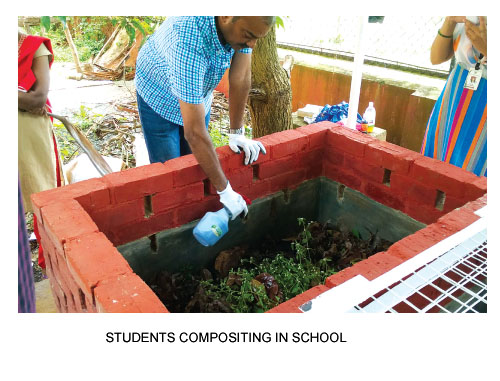
In a landmark ruling, the state of Goa notified 'The Goa Non-Biodegradable Garbage (control) act, 1996 and rules 1997'. This act mandates local bodies like Municipalities and Panchayats to collect and dispose off the solid waste generated in Goa. It provides a comprehensive legal framework to collect, manage, treat and dispose both biodegradable as well as non-biodegradable waste in a scientific manner.
WHAT CAN YOU DO
- PRE-CYCLE minimize consumption and reduce waste generation in the first place!
- SEGREGATE separate the biodegradable component (wet) from the non-biodegradable component (dry) to divert 40-50% of your waste entering into the garbage stream.
- COMPOST the wet waste and derive high quality manure and improve soil fertility.
- REUSE & RECYCLE reuse whatever you can before junking it. Further, try and recycle the same product into a newer one once it has exhausted its life.
Subscribe to our Newsletter!
Essay on Pollution for Students and Children
500+ words essay on pollution.
Pollution is a term which even kids are aware of these days. It has become so common that almost everyone acknowledges the fact that pollution is rising continuously. The term ‘pollution’ means the manifestation of any unsolicited foreign substance in something. When we talk about pollution on earth, we refer to the contamination that is happening of the natural resources by various pollutants . All this is mainly caused by human activities which harm the environment in ways more than one. Therefore, an urgent need has arisen to tackle this issue straightaway. That is to say, pollution is damaging our earth severely and we need to realize its effects and prevent this damage. In this essay on pollution, we will see what are the effects of pollution and how to reduce it.

Effects of Pollution
Pollution affects the quality of life more than one can imagine. It works in mysterious ways, sometimes which cannot be seen by the naked eye. However, it is very much present in the environment. For instance, you might not be able to see the natural gases present in the air, but they are still there. Similarly, the pollutants which are messing up the air and increasing the levels of carbon dioxide is very dangerous for humans. Increased level of carbon dioxide will lead to global warming .
Further, the water is polluted in the name of industrial development, religious practices and more will cause a shortage of drinking water. Without water, human life is not possible. Moreover, the way waste is dumped on the land eventually ends up in the soil and turns toxic. If land pollution keeps on happening at this rate, we won’t have fertile soil to grow our crops on. Therefore, serious measures must be taken to reduce pollution to the core.
Get English Important Questions here
Types of Pollution
- Air Pollution
- Water Pollution
- Soil Pollution
How to Reduce Pollution?
After learning the harmful effects of pollution, one must get on the task of preventing or reducing pollution as soon as possible. To reduce air pollution, people should take public transport or carpool to reduce vehicular smoke. While it may be hard, avoiding firecrackers at festivals and celebrations can also cut down on air and noise pollution. Above all, we must adopt the habit of recycling. All the used plastic ends up in the oceans and land, which pollutes them.

So, remember to not dispose of them off after use, rather reuse them as long as you can. We must also encourage everyone to plant more trees which will absorb the harmful gases and make the air cleaner. When talking on a bigger level, the government must limit the usage of fertilizers to maintain the soil’s fertility. In addition, industries must be banned from dumping their waste into oceans and rivers, causing water pollution.
To sum it up, all types of pollution is hazardous and comes with grave consequences. Everyone must take a step towards change ranging from individuals to the industries. As tackling this problem calls for a joint effort, so we must join hands now. Moreover, the innocent lives of animals are being lost because of such human activities. So, all of us must take a stand and become a voice for the unheard in order to make this earth pollution-free.
Get the huge list of more than 500 Essay Topics and Ideas
FAQs on Pollution
Q.1 What are the effects of pollution?
A.1 Pollution essentially affects the quality of human life. It degrades almost everything from the water we drink to the air we breathe. It damages the natural resources needed for a healthy life.
Q.2 How can one reduce pollution?
A.2 We must take individual steps to reduce pollution. People should decompose their waster mindfully, they should plant more trees. Further, one must always recycle what they can and make the earth greener.
Customize your course in 30 seconds
Which class are you in.

- Travelling Essay
- Picnic Essay
- Our Country Essay
- My Parents Essay
- Essay on Favourite Personality
- Essay on Memorable Day of My Life
- Essay on Knowledge is Power
- Essay on Gurpurab
- Essay on My Favourite Season
- Essay on Types of Sports
Leave a Reply Cancel reply
Your email address will not be published. Required fields are marked *
Download the App

- DOI: 10.1080/1369801X.2022.2157308
- Corpus ID: 254814447
The Role of Purity and Pollution Rituals in Religious Conversions of Goa During Portuguese Colonization: A Probe Through Select Goan Novels
- Smita Sail , M. G. Priya
- Published in Interventions 16 December 2022
- Interventions
67 References
Conversion, continuity and change: lived christianity in southern goa, flight of the deities: hindu resistance in portuguese goa, hindu-catholic encounters in goa: religion, colonialism, and modernity, the inquisition tribunal in goa: why and for what purpose.
- Highly Influential
Missionary Tropics: The Catholic Frontier in India (16th-17th Centuries)
The portuguese in india, goa during the first century of portuguese rule, the marrano factory: the portuguese inquisition and its new christians 1536-1765, concept of purity in the studies of the indian caste system, ritual pollution as an integrator of caste and religion, related papers.
Showing 1 through 3 of 0 Related Papers
Goa Air Quality Index (AQI)
Real-time PM2.5, PM10 air pollution level India
Last Update: 03 Jul 2024, 08:10am
Primary Pollutant

Air Quality Map
Comparative exposure with goa.
24 hrs avg AQI
Major Air Pollutants in Goa
The current PM2.5 concentration in Goa is 1.3 times above the recommended limit given by the WHO 24 hrs air quality guidelines value.
Goa - Cities Air Pollution Level
| Status | AQI | AQI-US | AQI-IN | PM2.5 | PM10 | Temp | Humid | |
|---|---|---|---|---|---|---|---|---|
| MODERATE | 70 | 70 | 39 | 21 | 39 | 28 | 82 | |
| MODERATE | 68 | 68 | 39 | 20 | 39 | 28 | 83 | |
| MODERATE | 64 | 64 | 46 | 18 | 46 | 27 | 83 |
Weather Conditions in Goa
Health Advice For Goa
Stay Indoor
Use Purifier
Goa Air Quality Forecast
India - Metro Cities AQI
Historic air quality graph of goa.
Oct 1, 2020
Explore an insightful air pollution data for last 24 hrs, 7 days & 1 month
Pocket CO 2 Monitor
Check if there is fresh air.
Pocket PM2.5 Monitor
Check real-time air quality.
FAQs of Goa's Air Quality Index
(frequently asked questions).
Quick answers to some commonly asked questions about the air pollution of Goa.
The real-time air quality in Goa is 44 (MODERATE) AQI now. This was last updated 15 minutes ago .
The current concentration of PM2.5 in Goa is 19 (µg/m³). The World Health Organisation (WHO) recommends 15 µg/m³ as the threshold concentration of PM2.5 for 24 hrs mean. Currently, the concentration is 0.76 times the recommended limit.
Generally, the air quality at Goa starts deteriorating in late October. The winters are the worst-hit season in terms of air pollution.
You should wear a good N95 mask when you go outdoor in Goa until the AQI is improving upto moderate range.
Office going people should avoid personal vehicles and use public transportations or carpooling.
(i) The primary causes of outdoor air pollution are solid, liquid particles called aerosols & gase from vehicles emissions, construction activities, factories, burning stubble & fossil fuels and wildfire, etc.
(ii) Main causes of indoor air pollution are harmful gases from cooking fuels (such as wood, crop wastes, charcoal, coal and dung), damp, mould smoke, chemicals from cleaning materials, etc.
Indoor air pollution in Goa is as dangerous as outdoor pollution, because the air pollutants come inside the houses or buildings through doors, windows and ventilation.
In Goa, you must use an air purifier or fresh air machine at home or office indoor and close all the doors, windows and ventilations when the outdoor air quality index (aqi) in Goa is very high. Proper ventilation is highly recommended only when outdoor air quality is improving and moderate AQI range.
World's Most Polluted Cities & Countries AQI Ranking
Real-time top most polluted cities, and monthly & annual historic aqi ranking of cities & countries, most polluted cities, live 100 ranking, world's most polluted, cities ranking, countries ranking, air quality solutions for goa.
Find out Prana Air's air quality monitors & solutions to fight air pollution in your city.
Air Quality Monitor
Know what the quality your are breathing with Prana Air monitors (low-cost & accurate).
Air Quality Sensor
Analyze the quality of air anywhere with accurate & compact gas & pm sensors.
Air Purifier
Purify your indoor air & make it free from air pollution and toxins with our air purifier.
Car Cabin Filter
Make sure you breathe fresh inside your car with a highly efficient car cabin filter.
N95 Pollution Mask
Breathe pure air with Prana Air motorized masks of multi-layer hepa filter purification.
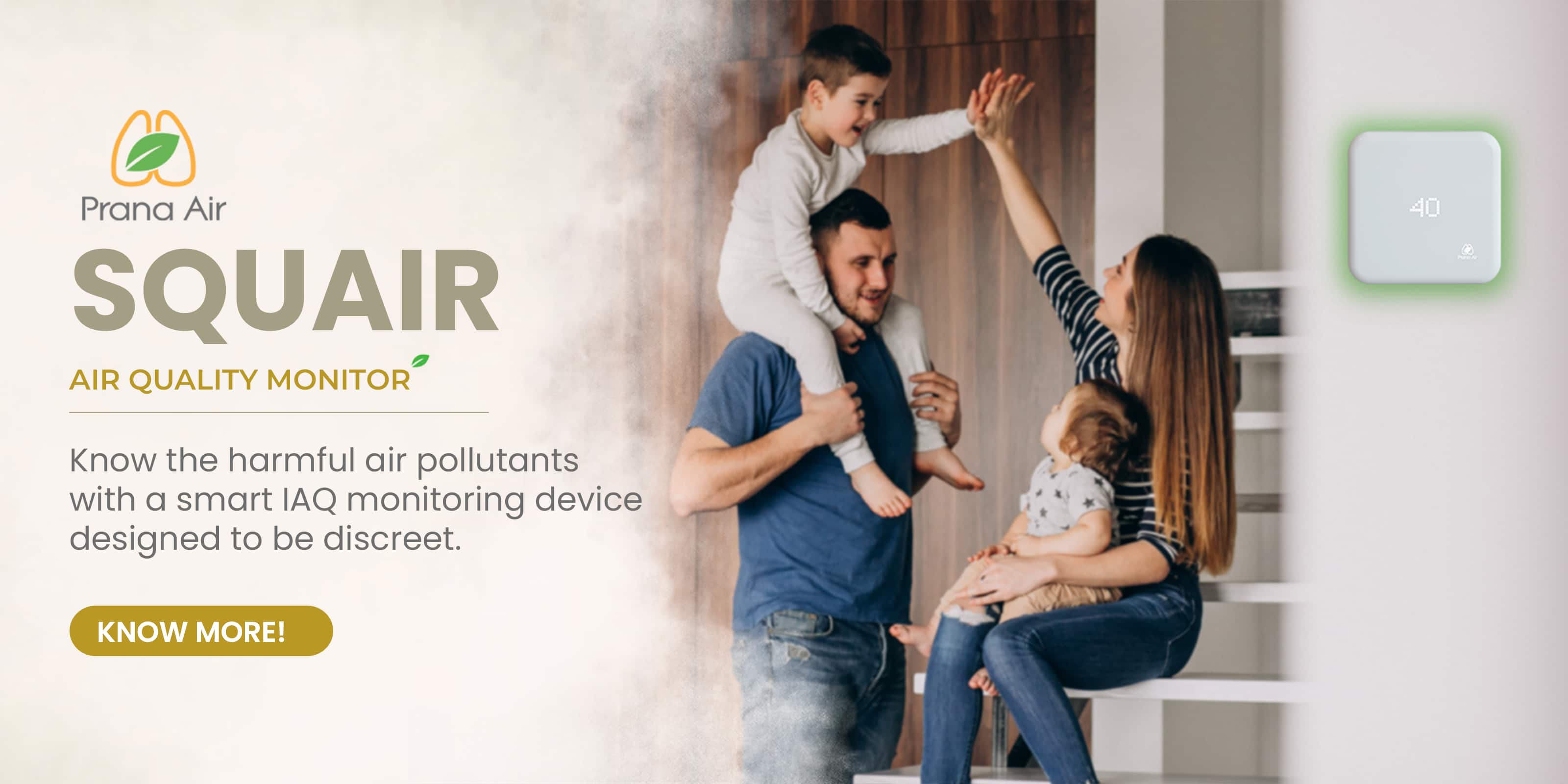
Keep a track of Goa Air Pollution Level On “ AQI Air Quality App ”
Know what you breathe and the quality of air in your city and nearby locations. Real-time AQI, map, weather & fire data, health advice with insightful & analytical dashboards.

- Skip to main content
- Skip to secondary menu
- Skip to primary sidebar
- Skip to footer
A Plus Topper
Improve your Grades
Essay on Goa | Goa Essay for Students and Children in English
February 13, 2024 by Prasanna
Essay on Goa: Goa is the smallest state in western India with coastlines of the Arabian Sea. On 30th May 1987, Goa was declared as a state of India. Goa’s capital is Panaji City; its world-class beaches, food, friendly people are the attraction of Goa.
Goa is mainly known for world-famous beaches. Goa is the hub of a variety of alcohols at low prices. Most of the people think that Goa is full of beaches, but Goa has covered one-third of forests. Indian tourism always arranges colourful carnivals in Goa for youth.
You can also find more Essay Writing articles on events, persons, sports, technology and many more.
Long and Short Essays on Goa for Students and Kids in English
We provide students with essay samples on a long essay of 500 words and a short essay of 150 words on Goa for reference.
Long Essay on Goa 500 Words in English
Long Essay on Goa is usually given to classes 7, 8, 9, and 10.
Goa is a state on the southwestern coast of India. The location was recognized as the Konkan and geographically separated from the Deccan highlands with Western Ghats’ aid. It is encircled by Maharashtra’s Indian state toward the north and Karnataka toward the east and south, with the Arabian Sea shaping its western coast. With terraced hills, red churches, small rooftops, Panaji City stands as the Capital of Goa.
Goa’s historical background goes back to ancient times. However, Goa’s present-day territory was just settled as of late as 1987. Despite being India’s littlest state by region, Goa’s history set is both long and assorted. It imparts many similitudes to Indian history, particularly as to frontier impacts and a multi-social tasteful. The Usgalimal rock engravings are evidence of the upper Paleolithic or Mesolithic periods. It shows the earliest traces of human settlement in India.
The Mauryan and Satavahana Empires ruled contemporary Goa at some stage in the Iron Age and the Kadamba kingdom, Vijayanagara Empire ruled Goa during the medieval period, The Portuguese invaded Goa in 1510, defeating the Bijapur Sultanate. Portuguese rule lasted for around 450 years, and vigorously impacted Goan culture, food, and architecture. In 1961, the Indian Army annexed Goa following a 36-hour flight. In 1987, Goa conceded statehood. The originality of the city name Goa is indistinct. In antiquated writing, Goa was known by numerous names, for example, Gomanchala, Gopakapattana, Gopakapattam, Gopakapuri, Govapuri, Govem, and Gomantak.
When we hear about Goa, the first picture we imagine is the scenery: having a drink with your loved ones by the beach. Goa is known for its first-class beaches. Travellers normally know Goa as North and South Goa; the previous being the spot to be in case you’re anticipating an “occurring” occasion, and the last mentioned, if you need an additionally loosening up rest from your hectic life. Around fifty beaches are located in Goa; Goa’s dotted beaches are treated to eyes to see. Goa tourism always recommends visiting Morjim, Baga, Candolim & Calangute beaches. The sunset of beaches always shows you the philosophy and peace of life. Whether you’re planning a family holiday or cherishing moments with your friends, Goa has all ingredients to make a holiday feast for you.
In Goa, Cashew is a recognizing symbol. Some people even came here to buy cashew. Other than that, Feni is an authentic drink of Goa. It is a type of liquor that is created from cashew nuts and only produced in Goa. The Feni consumed in South Goa is generally of higher alcohol content (43-45% above) than the Feni produced in North Goa. Preparations of Pork and prawns are famous in Goa. Goa is also famous for colourful carnivals and a variety of alcohol.
Goa has the biggest contribution to the Indian economic system and Indian Tourism. With shocking common magnificence and energetic societies, Goa’s internal excellence isn’t difficult to see. More than sun-doused seashores and Rave parties, Goa’s friendly people, extraordinary food, recorded structures, and cosmopolitan nature are ever-superb.
Short Essay on Goa 150 Words in English
Short Essay on Goa is usually given to classes 1, 2, 3, 4, 5, and 6.
Goa was declared as the smallest state of India in 1987. Panaji is the capital of Goa. It’s world-class beaches, foods; friendly people are the attraction of Goa.
In Iron Age, The Maryann and Satavahana Empires and in the medieval period, the Kadamba kingdom, Vijayanagara Empire ruled Goa. In 1510, defeating the Bijapur Sultanate, Portuguese rule went on for around 450 years, And In 1987, Goa was declared as an independent state in India.
Goa has a big contribution to Indian Tourism every year. Goa has a minimum of fifty beaches to visit. One must go to Candolim & Calangute beach to treat your eyes for a lifetime. In Goa, Feni is a recognized liquor, created from cashew nuts and only produced in Goa. Goa is the hub of a variety of alcohols at low prices. Here you can taste a variety of preparations of prawn and pork. Indian tourism arranges many carnivals on the lap of beaches and forests of Goa.
10 Lines on Goa in English
- Goa is the smallest state in India.
- It is stated that Vasco da Gama discovered Goa in 1543 and gave a world over recognization.
- People of Goa speak in the Konkani language.
- Goa is known for world-famous beaches.
- Goa has all over fifty beaches.
- Goa has the most contributions to India Tourism.
- Goa has always been the first tourism spot to enjoy life.
- Goa is known for beaches, but Goa has covered one-third of forests.
- Goa is the only place where motorcycles are used for paid lifts.
- Portugal ruled in Goa for 450 years.
FAQ’s on Goa Essay
Question 1. What is Feni?
Answer: Feni is a one of a kind liquor that is created from cashew nuts and only produced in Goa.
Question 2. Is Goa safe at night?
Answer: Goa is very safe, even for solo travellers.
Question 3. Which is the language used in Goa?
Answer: The people of Goa used to speak Konkani. For business and official works, they use English, Hindi also.
Question 4. What is the origin of the name of Goa?
Answer: The originality of the city name Goa is indistinct. Goa was known by numerous names, for example, Gomanchala, Gopakapattana, Gopakapattam, Gopakapuri.
- Picture Dictionary
- English Speech
- English Slogans
- English Letter Writing
- English Essay Writing
- English Textbook Answers
- Types of Certificates
- ICSE Solutions
- Selina ICSE Solutions
- ML Aggarwal Solutions
- HSSLive Plus One
- HSSLive Plus Two
- Kerala SSLC
- Distance Education
Pollution in Goa, India
| Air Pollution | 28.57 | Low | |
| Drinking Water Pollution and Inaccessibility | 38.00 | Low | |
| Dissatisfaction with Garbage Disposal | 69.90 | High | |
| Dirty and Untidy | 57.00 | Moderate | |
| Noise and Light Pollution | 57.00 | Moderate | |
| Water Pollution | 62.50 | High | |
| Dissatisfaction with Spending Time in the City | 42.71 | Moderate | |
| Dissatisfaction with Green and Parks in the City | 46.20 | Moderate |
Purity and Cleanliness in Goa, India
| Air quality | 71.43 | High | |
| Drinking Water Quality and Accessibility | 62.00 | High | |
| Garbage Disposal Satisfaction | 30.10 | Low | |
| Clean and Tidy | 43.00 | Moderate | |
| Quiet and No Problem with Night Lights | 43.00 | Moderate | |
| Water Quality | 37.50 | Low | |
| Comfortable to Spend Time in the City | 57.29 | Moderate | |
| Quality of Green and Parks | 53.80 | Moderate |
- Quality of Life in Goa
- Cost of Living in Goa
- Crime in Goa
- Health Care in Goa
- Property Prices in Goa
- Traffic in Goa
| Your Email Address: | |
| Panaji | |
| Karwar | |
| Mandrem | |
| Belgaum | |
| Sawantwadi | |
| Dharwad | |
| Hubli | |
| Karnataka | |
| Sangli | |
| Davanagere (Davangere) |
Copyright © 2009-2024 Numbeo. Your use of this service is subject to our Terms of Use and Privacy Policy

IMAGES
VIDEO
COMMENTS
Conclusion. Addressing plastic pollution in Goa requires collaborative efforts from the government, businesses, residents, and tourists alike. By embracing sustainable practices, fostering community engagement, and promoting eco-conscious tourism, Goa can preserve its natural beauty for generations to come. Together, let us pledge to safeguard ...
For analyzing the status and quality of rivers of Goa, the data collected by Goa State Pollution Control Board were used in this study. The Board collected the information related to temperature, salinity dissolved oxygen, and pH of the selected rivers. They collected the information related to water quality in the specified months of the year ...
Given the scale of iron ore mining in Goa and the documented environmental issues, it was an ideal setting to study total exposure to air pollution. Footnote 1 For the purposes of this study, we divided the mining regions of Goa into five clusters, including a control cluster with no mining activity at the time of data collection between June ...
The state of Goa, in India, is known worldwide as a. * Corresponding author. Tel.: 011-24682100/41504900 Fax: 011-24682144/24682145. E-mail address: [email protected] tourist destination. The region, which is known for its pristine environment is on the path of rapid urbanization and economic growth.
The Goa State Pollution Control Board (GSPCB) has observed that major beaches - Miramar, Calangute, Morjim, Tiracol and Vagator in North and Mobor, Baina, Velsao and Galjibag in South are most polluted with high levels of faecal coliform. The water quality data analysis for the year 2021-2022, also revealed that State's major rivers - Mandovi ...
Goa is a tiny state covering an area of about 3702 sq. Km, with 105 km of coastline that includes about 74 km of sandy beaches. ... Goa Pollution Control Board ... This essay is a snapshot of Goa ...
ABSTRACTThis paper presents the first emission inventory for the highly urbanized state of Goa in India, which is an important international tourist destination and also accommodates significant industrial activities, including mining. The observed concentrations of the pollutants like PM10 and PM2.5 show violations at many locations. Sectoral inventories prepared in this study depicts mining ...
The estuaries of Goa are a rich source of different species of prawns (13 species). The occurrence of solar prawns in tonnes for a short period during July-August is an important feature of the ...
INTRODUCTION From a climate change perspective, vulnerability refers to how a system copes with the adverse effects of climate change (CC). The world's coastal areas represent only 20% of the available land, but host more than half of the global population. These areas are already stressed by high levels of human activity, pollution, invasive species, storms etc., and CC is accentuating it all.
In the Cotigao area in South Goa, it is not an uncommon sight to see women of the village lining up in front of the government water tanker. Five villages in the area, mostly inhabited by the Dhanger community, a nomadic herding tribe, have been facing an acute water shortage - so much so that in the first week of July, members and volunteers with a local environment group, Goa Green Brigade ...
CLIMATE CHANGE IMPACTS IN GOA. Climate change (CC) can have a far reaching effect by impacting just about every aspect of human life. It can affect our water resources, forests and other natural ecological systems, agriculture, power generation, infrastructure, tourism, and human health. The overall negative impacts of global CC will be less ...
Water pollution in India is primarily associated with unmanaged urbanization, population explosion, inadequate capacity of sewage treatment, and its disposal, which lead to unhygienic and insanitary conditions. This paper gives an overview on sewage treatment plants (STPs) in Goa—a coastal state in India. Being a famous tourist destination, it is important to monitor and control water ...
The continental shelf area of Goa extends to 10,000 km2 of about 100 fathoms depths. The current annual average marine and inland fish production is estimated at 86 027 and 3669 tonnes, respectively.
number of river stretches from pollution, and recycling treated sewage for reducing ever increasing pressure on our water resources, sewage treatment and reuse remains a neglected field in our country (CPCB 2005). History of STP in Goa Goa is the smallest state in India, with a geographical area of 3702 km2, 1736 km2 in North Goa and 1966 km2 ...
Academia.edu is a platform for academics to share research papers. Environment Engineering to Mitigate Environmental Pollution in Goa with Special Focus on Mining ... 978-1-63248-148-1 doi: 10.15224/978-1-63248-148-1-38 ENVIRONMENT ENGINEERING TO MITIGATE ENVIRONMENTAL POLLUTION IN GOA WITH SPECIAL FOCUS ON MINING Debasis Patnaik, Asst Prof and ...
Mining in Goa: Villages of Pissurlem, Shirgao, Bicholim in Goa's mining belt suffer deforestation, climatic change, soil erosion, air and water pollution as a consequence of iron ore mining as ...
This essay seeks to understand the role of purity and pollution rituals in the religious conversions of sixteenth-century Goa. We undertake to closely analyze the fictionalized instances of conversions in the select novels and draw references from historical documents.
This will divert at least 40-50% of the total waste being sent for disposal and therefore shrink all related operational costs. On 30 May 2016, Goa's 30th Statehood Day, a Solid Waste Treatment Plant (with a total capacity of 100 tonnes per day) was inaugurated at Saligao. The plant has been planned as a state-of-the-art modern facility based ...
500+ Words Essay on Pollution. Pollution is a term which even kids are aware of these days. It has become so common that almost everyone acknowledges the fact that pollution is rising continuously. The term 'pollution' means the manifestation of any unsolicited foreign substance in something.
The Colonial period of Goa, a small southwestern state of India, colonized by Portugal for over 450 years, is often considered a period of pollution and impurity. This essay seeks to understand the role of purity and pollution rituals in the religious conversions of sixteenth-century Goa. We undertake to closely analyze the fictionalized instances of conversions in the select novels and draw ...
Know what you breathe and the quality of air in your city and nearby locations. Real-time AQI, map, weather & fire data, health advice with insightful & analytical dashboards. Current Goa Air Quality Index (AQI) is 45 GOOD level with real-time air pollution PM2.5 (15µg/m³), PM10 (45µg/m³), Temperature (29°C) in India.
Essay on Goa: Goa is the smallest state in western India with coastlines of the Arabian Sea. On 30th May 1987, Goa was declared as a state of India. Goa's capital is Panaji City; its world-class beaches, food, friendly people are the attraction of Goa. Goa is mainly known for world-famous beaches.
Pollution in Goa, India. Compare Goa with: Do you live in Goa? Add data for Goa. Index. Pollution Index: 49.41. Pollution Exp Scale: 89.81.